Is the blast furnace on the way out or here to stay?
Two articles on the European Union’s CBAM
Refractories and the green steel transition
Biden’s bid for industrial decarbonization
www.steeltimesint.com


Is the blast furnace on the way out or here to stay?
Two articles on the European Union’s CBAM
Refractories and the green steel transition
Biden’s bid for industrial decarbonization
www.steeltimesint.com

Metals offers the entire steel value chain an exceptional opportunity for curbing their CO2 emissions.
The unique combination of its historic and recently developed product portfolio, make John Cockerill one of the industry’s most relevant suppliers of equipment for both the hot and cold phase of the steelmaking and processing industry.
Our three distinct business segments are addressing todays and tomorrow’s challenges supporting sustainable and green steel production:
Our new upstream offering related to DRI (Direct Reduced Iron), EAF (Electric Arc Furnaces) technologies and the use of hydrogen in steelmaking. Next to offering indirect electrification (DRI-EAF&H2-DRI-EAF),John Cockerill is also working on Volteron®: A first-of-a-kind iron reduction and steel processing route via direct cold electrolysis. This CO2 free steelmaking process, has been co-developed with the world’s leading steelmaker ArcelorMittal.
Regrouping our historical downstream product portfolio, this segment also includes:
¡ the Jet Vapor Deposition (JVD®) technology set to replace today’s hot-dip or electro galvanizing processes. This novel high-productivity vacuum coating technology provides previously unknown coating flexibility and possibilities, all while offering lower CAPEX and OPEX.
¡ our E-Si® equipment & processing lines specifically designed to produce high-quality Non-Grain Oriented (NGO) steel in response to the need for electrical steel meeting precise metallurgical properties, essential to support the shift towards green mobility.
This segment not only embraces all services and after-sales activities but will be strongly focusing on downstream furnace electrification (reheating and processing line furnaces), as well as hydrogen combustion, and the optimization of plant operations, including energy audits and the modernization of steel production equipment and installations.

17 - 19 June 2024
New York Marriott Marquis



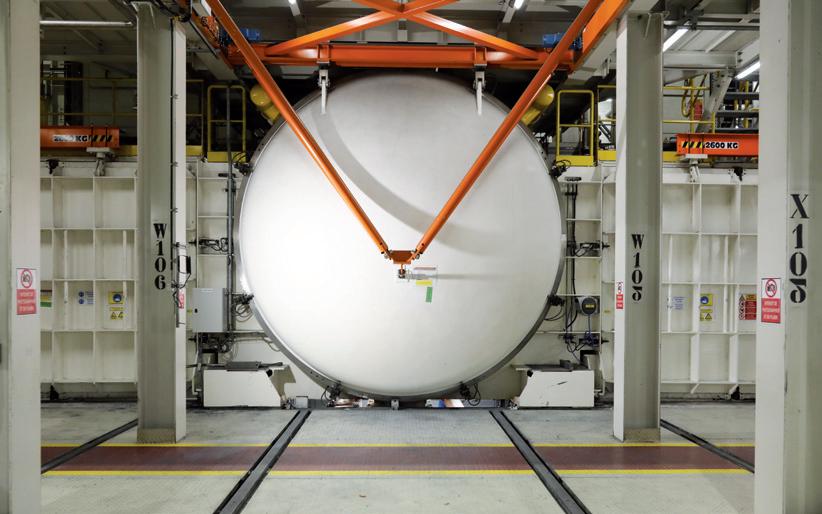




EDITORIAL
Editor
Matthew Moggridge
Tel: +44 (0) 1737 855151
matthewmoggridge@quartzltd.com
Assistant Editor
Catherine Hill
Tel:+44 (0) 1737855021
Consultant Editor
Dr. Tim Smith PhD, CEng, MIM
Production Editor Annie Baker
Advertisement Production Carol Baird
SALES
International Sales Manager
Paul Rossage
paulrossage@quartzltd.com
Tel: +44 (0) 1737 855116
Sales Director
Ken Clark
kenclark@quartzltd.com
Tel: +44 (0) 1737 855117
Managing Director
Tony Crinion
tonycrinion@quartzltd.com
Tel: +44 (0) 1737 855164
Chief Executive Officer Steve Diprose
SUBSCRIPTION
Jack Homewood
Tel +44 (0) 1737 855028
Fax +44 (0) 1737 855034 Email subscriptions@quartzltd.com
(inc
Published by: Quartz Business Media Ltd, Quartz House, 20 Clarendon Road, Redhill, Surrey, RH1 1QX, England. Tel: +44 (0)1737 855000 Fax: +44 (0)1737 855034 www.steeltimesint.com
Steel Times International (USPS No: 020-958) is published monthly except Feb, May, July, Dec by Quartz Business Media Ltd and distributed in the US by DSW, 75 Aberdeen Road, Emigsville, PA 17318-0437. Periodicals postage paid at Emigsville, PA. POSTMASTER send address changes to Steel Times International c/o PO Box 437, Emigsville, PA 17318-0437. Printed in England by: Stephens and George Ltd • Goat Mill Road • Dowlais • Merthyr Tydfil

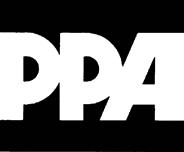
2 Leader By Matthew Moggridge.
4
News round-up
The latest global steel news.
10
Innovations
The latest products and contracts.
13
USA update
Biden’s bid for industrial decarbonization.
15
Latin America update SINOBRAS: Doubling its rolling mill capacity (Part 1).
19
India update
Demand falls, exports surge.
21
Decarbonization
Prepare for CBAM compliance.
24
Decarbonization
CBAM: ensure you have your reporting in check by July 2024.
Ironmaking The future of ironmaking.
Blast furnaces Past the tipping point?
Structural steel
Flattening out. 40
Green steel
Calderys refractories and the transition to green steel.
44
Ukrainian steel market Ukrainian steel industry in 2035: green and domestically focused.
46
Raw materials
Coal microlithotypes: coke quality.
48
Perspectives: Weiler Abrasives Wheeling along. 51 History
The Levant Man Engine disaster.

 Matthew Moggridge Editor
Matthew Moggridge Editor
matthewmoggridge@quartzltd.com
To tell the truth, I don’t know what it is. Déjà vu? That something doesn’t show up for a while doesn’t mean it ceases to exist. I’ve had a few strange occurences of late, the last one being earlier this week when I reached home and found Dance Moms on the TV. Abby Lee having to contend not only with a bunch of energetic kids but also their demanding ‘moms’ determined to get their female offspring the fame and fortune they think they deserve, plenty of arguments, many kids in leotards and make-up when they should, perhaps, be running wild in the park or riding a bike or making mud pies, but instead they’re upset about something or other; it’s a laugh a minute (or it was). When my daughter was younger it was always on and I was often invited to sit and watch, which I did, but now I was baffled. Why was it on again? My wife was watching it! Why? There was no answer and I’ll admit that I sat there, engrossed again and eager to find out whether they won the dance competition in Arizona. It’s strange how things drift back into my life and I’m sure it’s the same for all of us. But let’s put Dance Moms aside, I must keep with the programme; this is, after all,
an international steel magazine, but when you’re writing leader articles you need a hook and mine was Dance Moms and Déjà vu and you might be wondering why. Well, some years ago, when I started on this magazine, every conference I attended dealt with just one subject: China. And then, it disappeared, replaced by one word: decarbonization. I thought I’d heard the last of the phrase ‘all we want is a level playing field’, but no, it’s back, along with ‘tariffs’ and ‘countervailing duties’ and ‘anti-dumping legislation’. But here’s the thing: it’s never gone away, but now, like Dance Moms, it’s re-appeared, possibly because we’re all suffering from decarb fatigue. It is time to refocus on the problem of overcapacity. It played a role in Máximo Vedoya’s keynote presentation at AISTech’s President’s Award Breakfast earlier this month and – thankfully – the American steel industry and President Joe Biden who is likely up against Donald Trump later this year, are in a combative mood and determined to get to grips with the problem. It’s not just steel in the firing line but also Chinese electric vehicles, solar panels and other goods. The pressure needs to be kept up and I’m sure it will be.
We are your premium partner for refractory solutions for the heat treatment of steel
We offer solutions of the highest performance to meet your most demanding requirements. With RATH you can count on:
• A comprehensive range of premium refractories
• Engineering, production, on-site supervision
• Solutions to reduce your carbon footprint and to save energy
• No compromise on quality, here we remain as tough as steel











































To be the leading partner for our customers in this transformation, SMS group bundles all competencies from electrics/automation, digitalization, and technical service. Our goal is to maintain and expand the performance of our customers' plants throughout their entire lifecycle. Together with our customers, we develop integrated solutions speci cally geared to the customer's use case. In doing so, we focus on crucial KPIs such as plant availability, product quality, productivity, or delivery reliability but also on increasingly relevant topics such as sustainability and safety.

UAE-based Green Metal Industries has earmarked $100 million to set up a steel recycling and manufacturing plant located in AD Ports’ Khalifa Economic Zones Abu Dhabi (Kezad), according to a statement released in April. Located in the Kezad industrial area, Kezad Al Ma’mourah, the plant will span 116,000 m2 and is set to commence commercial operations in early 2025. The plant will locally source scrap metal and convert it into high-quality steel materials, according to the statement.
Source: Enterprise, 1 April 2024.

ArcelorMittal Zenica has revealed plans to close its coke plant due to ‘escalating costs and dwindling demand.’ The plant has operated for over 40 years but was inactive from 1992 to 2008. The steelmaker stated that


Tata Steel is investing around $795 million in the equity of its subsidiary Neelachal Ispat Nigam Limited (NINL) to implement its long products expansion plan, according to media reports. The investment is planned to be made over two years, and is subject to shareholder approval. The company is located near Tata Steel’s steel plant in Kalinganagar, Odisha, where a project to increase production capacity by 5Mt/ yr is underway. While the expansion in Kalinganagar is expected to increase the company’s offer in the flat products segment (hot and cold rolled coils), NINL will focus on long products (wire, bars and wire rod).
Source: GMK Center, 1 April 2024.
ongoing maintenance hasn't prolonged its lifespan, and upgrades fail to meet environmental standards. The company's CEO, Nikhil Mehta, expressed the company's commitment of minimizing the impact on the local economy and preserving jobs by facilitating employee transfers to other Zenica plants.
Source: Yieh Corp Steel News, 2 April 2024.

British Steel has won a multimillion-pound contract to supply rail for a new route in north Africa, the company has announced. Approximately 9.5kt of track, produced in Scunthorpe, will be provided for Egypt’s first fully electrified mainline and freight network which stretches from the Red Sea to the Mediterranean. The network is 410 miles long and will carry trains for passengers and goods up to a maximum speed of 155mph.
Source: The Guardian, 2 April 2024.

Producers of renewable hydrogen, green H2-derived iron and steel and green ammonia will shortly be eligible for free allowances under the EU’s carbon trading mechanism, after updated rules were published in the

India’s JSW Vijaynagar Metallics (a subsidiary of JSW Steel) has commissioned a 5Mt/yr hot strip mill at its integrated steel plant in Vijaynagar, Karnataka. The company started trial operation of the equipment in March this year, and after the inspection, it launched commercial production and sales, with the first products already shipped. The hot strip mill can produce plates and coils, and is equipped with digital heating furnaces, evaporative cooling, and waste heat recovery systems.
Source: GMK Center, 2 April 2024.
EU’s official journal. The new rules, agreed after a long legislative passage that began last year, essentially corrects a glitch in the Emissions Trading System (ETS) rules that granted free allowances to producers of fossil fuel-intensive industries, but not their decarbonized equivalents.
Source: Hydrogen Insight, 4 April 2024.
21 workers were admitted to hospital following reports of a gas leak at SAIL’s Bokaro steel plant. Sources claim that maintenance work had been in progress in the mixed gas pipeline, which supplies gas to the re-heating furnace of the hot strip mill. An alarm was initially called due to smoke coming from the pipeline, and a spreading fire. Source: Indian PSU, 6 April 2024.

























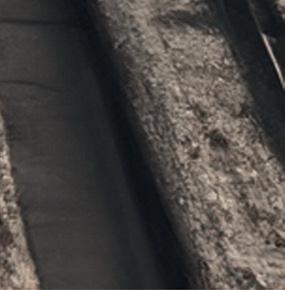




















www.tii-kamag.com














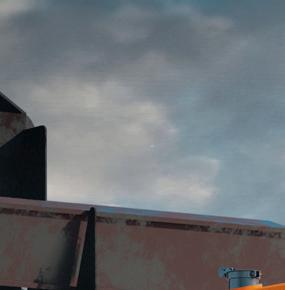













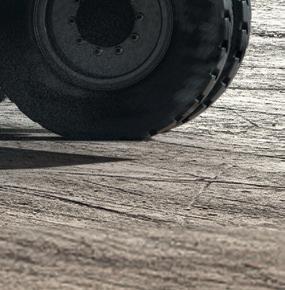
























A team of University of Wollongong (UOW) researchers has secured funding worth $4.2 million from the Australian Renewable Energy Agency (ARENA) and industry partner BlueScope Steel to investigate ways of utilising low- and medium-grade iron ore in low-emission steelmaking and further decarbonizing domestic steel production. Project leaders, Dr Xue Feng Dong, Dr Raymond Longbottom, Professor Brian Monaghan, and Dr Paul Zulli, of UOW’s School of Mechanical, Materials, Mechatronic and Biomedical Engineering, will explore the viability of Australia’s abundant, low-to-medium grade Pilbara iron ores in a potential breakthrough, low-emissions, electric smelting furnace (ESF)-based steelmaking route.
Source: University of Wollongong, 10 April 2024.


A steel business in Birmingham, UK, has said it cannot be run effectively, because of fly-tipped rubbish outside. FH Warden (Steel) said deliveries had been blocked and it stood to lose thousands of pounds in trade. Steel firm owner Patricia Hughes said after through traffic was stopped, Adderley Road South ‘effectively became a cul-de-sac’ and it was a ‘fly-tippers paradise’. Birmingham City Council said it investigated incidents and ‘did not hesitate in taking enforcement action’. The council cleared what was there, Hughes said, with the latest rubbish arriving in early April. The authority had responded, but it was ‘not good enough, because [the company] now cannot run business effectively due to fly-tipping impacting on the firm's gates.
Source: BBC. 9 April 2024.
the last mill still operating in what was once the Weirton Steel Works, located about 40 miles west of Pittsburgh. In making the announcement, Cleveland-Cliffs placed blame on the US International Trade Commission (ITC) for failing to impose tariffs on tin products imported from Canada, Germany, China, and South Korea.
Source: WSWS.org, 11 April 2024

Metallus, formerly known as TimkenSteel, a provider of specialty metals, manufactured components and supply chain solutions, has announced its membership of the Global Steel Climate Council (GSCC). This partnership, says the company, underscores its dedication to environmental stewardship and marks another milestone in the company's sustainability journey. The GSCC serves as a platform for industry leaders to collaborate, share best practices, and aims to drive collective action toward reducing greenhouse gas emissions across the steel value chain.
Source: PR Newswire, 10 April 2024.

ArcelorMittal Poland, the Polish division of global steelmaker ArcelorMittal, plans to invest about $25.2 million to modernize and expand the product portfolio of its galvanizing plant in Krakow. The company aims to expand its product range with new coatings based on zinc, magnesium, and aluminium. The new production facilities are scheduled to be commissioned in 2025 and production will begin in 2026 after certification.
Source: GMK Center, 11 April 2024.
A fire broke out at Evraz's steel plant in Pueblo, Colorado. All operations restarted after a brief pause, which affected steelmaking operations. Evraz North America CEO Skip Herald said the fire did not affect the steelmaking facilities, rolling mill, or Palmer project construction. Employees and contractors in the affected areas were evacuated. Emergency crews were able to control the fire, and the US Environmental Protection Agency said that the emergency crews had determined that no hazardous materials were present in the fire and were investigating the cause of the fire.

Source: Yieh Corp Steel News, 11 April 2024

Benteler Steel plans to spend $21 million expanding its facility at the Port of CaddoBossier in northwest Louisiana and create nearly 50 new jobs, US state officials have said. Louisiana Economic Development announced that the company will add a new threading facility for hot rolled seamless steel tubes to its existing operations. Construction was scheduled to begin at the end of April and will be executed in two phases.
Source: AP, 13 April 2024

SSAB has signed a letter of intent for deliveries of its fossil-free steel to Francebased materials handling and earthmoving equipment maker Manitou Group. The SSAB fossil-free product line includes SSAB Zero, a steel made from recycled scrap


According to reports by Kallanish, China’s Baowu Group is taking steps to reduce carbon emissions as the group’s enterprises implement relevant projects.
The Ma’anshan Iron & Steel (Magang) steel plant has started implementing a carbon management system at the end of March 2024, and is the first plant within the Baowu Group to do so. Magang’s carbon management system will cover all relevant activities, including carbon trading and carbon asset management.
Source: GMK Center, 13 April 2024
using fossil-free energy sources, which the company says results in virtually zero emissions from the steelmaking process. The steelmaker already delivers specialized and high-strength steels to Manitou Group, and the companies are now furthering their collaboration by adding future deliveries of the emission-free steels, SSAB Fossil-free and SSAB Zero, to the mix.
Source: Recycling Today, 15 April 2024.

The Liberia National Police (LNP) and ArcelorMittal Liberia (AML) have signed a memorandum of understanding (MOU) aimed at ensuring the secure movement of AML’s equipment from Buchanan, Grand Bassa County, to Tapata, Namba County. Due to logistical constraints, the LNP could only commit to providing one escort vehicle instead of the requested two. In response to the LNP’s request, AML pledged to provide two new vehicles to enhance police operations during the transportation of oversized equipment. The company said this would demonstrate their commitment to safety and cooperation.
Source: GNN Liberia, 14 April 2024


Nippon Steel has suspended production at some of its blast furnaces at the company's Kimitsu plant due to operational issues, said the company, without disclosing further details. The suspension is temporary, a company representative stated, although it remains unclear when the plant will resume production. The firm has not disclosed output volumes at the Kimitsu plant.
Source: Argus Media 15 April 2024.
Russian steelmaker Severstal has acquired a St Petersburg holding company that controls a majority stake in a joint venture previously owned by Spanish firm Windar Renovables. The acquisition of New Solutions and Technologies LLC makes Severstal the sole owner of its former joint venture with Windar, which manufactures towers for wind turbines. Severstal has owned 100% of the holding company since 8 April, a state register has shown.
Source: Reuters, 16 April 2024.
Thyssenkrupp has agreed to sell a stake in its steel business to a group owned by Czech billionaire Daniel Kretinsky, as the German conglomerate seeks to overhaul the ‘long-troubled unit,’ as stated in local media reports. Kretinsky's EP Corporate Group (EPCG) will initially acquire 20% of Thyssenkrupp Steel Europe, in a deal expected to close in the current financial year, the companies said in a statement. Talks are ongoing for EPCG to take a further 30% stake at a later
point with the aim of eventually reaching a 50-50 joint venture. Source: Barrons, 26 April 2024.

The Serious Fraud Office has visited the offices of Sanjeev Gupta’s Liberty Steel. It comes almost a year after the SFO launched an investigation into suspected fraud and money laundering by parent firm GFG Alliance, which has thousands of staff in the UK. The SFO has confirmed that teams from the organisation visited company offices in April to request documents including company balance sheets, annual reports and correspondence related to the investigation.
Source: yahoo!life, 27 April 2024.
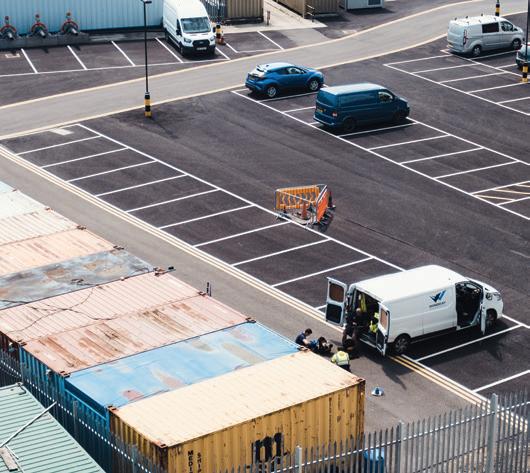
ArcelorMittal has warned that one of its divisions may end up leaving the UK if a planning application in a town in south-east England is approved. In a letter seen by Sky News, the Luxembourgbased conglomerate said if a planning application was approved, and part of Chatham Docks in Kent was closed and redeveloped, there would be ‘seismic adverse consequences’ for several important industries and

Chemical company Linde has signed a long-term agreement with H2 Green Steel for the supply of industrial gases to the world's first largescale green steel production plant. Linde will invest approximately $150 million to build, own and operate an on-site air separation unit (ASU) in Boden, northern Sweden. Linde will supply oxygen, nitrogen, and argon to H2 Green Steel's integrated plant, which will use the latest technology to reduce carbon emissions by up to 95% compared to traditional steelmaking.
Source: yahoo!finance, 1 May 2024.
the UK economy as a whole. The redevelopment would necessitate the closure of the docks which Arcelor Mittal uses to supply reinforcement materials for the construction industry.
Source: N Business, 6 May 2024.


UK-based steelmaker and engineering firm, Sheffield Forgemasters, has completed multiple land purchases in the Meadowhall area of the city. The purchases total 21 acres of brownfield land over three plots adjacent to the company’s Brightside Lane site, with the aim of developing additional facilities as its recapitalisation programme gears up. Gareth Barker, chief operating officer at Sheffield Forgemasters, said: “The purchase of these plots of land is a gamechanging venture for the company and will see stateof-the-art manufacturing facilities built in the historic centre of Sheffield’s industrial heartland.’’
Source: Production Engineering Solutions, 2 May 2024.
JFE Steel Corporation has launched a solutions-business brand, JFE Resolus™ to provide solutions to a range of customers, including those outside the steel industry, based on manufacturing and operation technologies that JFE Steel has cultivated over many years in its steelmaking operations. JFE Steel’s recently launched solutions business website showcases diverse

Nippon Steel Corp has postponed the expected closing of its $14.1 billion takeover of US Steel by three months after the US Department of Justice requested more documentation related to the deal. Nippon Steel said the deal, already approved by US Steel's shareholders, is still expected to go through. “Nippon Steel will continue to fully co-operate with the examination of the relevant authorities,” it said in a statement. The sale has drawn opposition from president Joe Biden’s administration on economic and national security grounds, and from former president Donald Trump, the likely Republican presidential candidate in November's election.
Source: Japan Today, 4 May 2024.
products and technologies, including digital technologies, Cyber-Physical Systems (CPS), and robotics, for purposes such as improving production efficiency, increasing labour productivity, manufacturing value-added products and reducing environmental impact.
Source: JFE Steel Corporation, 7 May 2024.

TII SCHEUERLE has launched the fourth generation SCHEUERLE BladeLifter, which the company claims allows all fleet operators to have a high level of investment security as well as economic efficiency, and offers transport safety even when transporting the longest rotor blades. The Steil Kranarbeiten company has used this solution for transports of rotor blades up to 84 metres long to wind farm facilities.
The BladeLifter G4 system has sufficient reserves to accommodate future rotor blades, and the high set-up angle of 60 degrees is designed to ensure the best possible manoeuvrability. The BladeLifter G4 can be operated using two widths,
namely 3 and 3.49 metres. On the one hand, this facilitates a high level of driving stability as well as structural integrity when transporting large rotor blades and, on the other, more compact designs with reduced space requirements.
In addition, the rotor blade adapter from TII SCHEUERLE can also be adapted to suit different root diameters and also features a new height adjustment characteristic to allow it to be driven under bridges when loaded. TII SCHEUERLE has also developed a drawbar coupling element in order to support the self-propelled combination when negotiating extreme gradients or to be pulled quickly with a tractor unit during empty

Tenova, a developer and provider of sustainable solutions for the green transition of the metals industry, is partnering with RINA, a multinational engineering consultancy, inspection, and certification company, on the European Commission-backed Hydra project.
The €88M project is funded by the European
Commission’s NextGenerationEU and backed by the Italian Ministry of Enterprises and Made in Italy. It aims to drive 100% hydrogen-fueled steel production and allow all steelmakers to test it, using the results to drive future investment plans towards sustainable production of steel.
Tenova has been contracted to supply a
runs. Both accelerate the transportation process and save time, it is claimed.
Another advance in the latest generation of the BladeLifter is the optimized remote diagnosis feature and stability monitoring. With the help of remote diagnosis, fleet operators gain access to all status updates of the transport solution. The optimized working lights system, which is activated by means of a remote control, also contributes to user-friendliness and work safety.
For further information, log on to www.tii-group.com
30-metre-tall direct reduction iron ore (DRI) tower which will use hydrogen as a reducing agent, and an electric arc furnace (EAF). The DRI plant, based on the ENERGIRON® Direct Reduction technology, jointly developed by Tenova and Danieli, together with the Tenova EAF will produce up to seven tons per hour at its full production capability within 2025.
“I am very proud of this project with RINA as it provides all European steelmakers the first opensource facility that will enable them to test the process with our pilot plant and drive their future investments to drastically reduce their emissions,” said Roberto Pancaldi, Tenova CEO. “Our co-operation with RINA dates back to the nineties with several projects successfully developed”.
“Hydra aims at decarbonizing the steel production process through hydrogen-based technologies,” added Carlo Luzzatto, CEO, and general manager of RINA. “Thanks to the help of our partners, we will build a pilot plant to experiment with steel production, emitting a marginal fraction of the carbon emissions currently released by the world steel industry. Hydra is available to the entire supply chain for research and development on the production of clean steel”.
For further information, log on to www.tenova.com
Haver & Boecker Niagara, a manufacturer of screening, pelletizing and mineral processing plants and systems for the mining, aggregate and industrial mineral industries, has launched Rhino Hyde liners, which the company claims will enhance the wear life of a full range of equipment. The company’s custom-blend liners are formulated and installed on key wear, material handling and impact areas of chutes, hoppers, vibrating screens and more. Rhino Hyde, constructed from thermoset polyurethane, boasts superior abrasion resistance, says the company, as well as enhanced durability and chemical resistance compared to alternatives like thermoplastic polyurethane, rubber, or metal.
“Haver & Boecker Niagara consistently seeks innovative solutions that elevate our customers’ operations,” said Karen Thompson, president of Haver & Boecker Niagara’s North American and Australian operations. “Offering Rhino Hyde liners underscores our commitment to delivering products and services that go well beyond the ordinary or expected. They aren’t just off-theshelf products; they’re meticulously tailored

solutions developed through collaboration with our partners and customers. It’s this dedication to personalized excellence that sets us apart.”
Rhino Hyde liners are designed for applications such as screening, material handling and hauling. They can be fully customized to the required size and are available in multiple different styles and attachment systems including the classic Rhino
Hyde Blue, magnetic, urethane-backed ceramic, polyurethane blades, belt skirting and weldable liners.
For further information, log on to https://haverniagara.com

Lock Joint Tube, a US steel tube manufacturer, has contracted Fives to supply a completely automatic tube mill to expand its capacity and meet growing demand for renewable energy.
Lock Joint Tube is doubling production at its plant in Temple, Texas to provide solar tubes to key customers who are investing in the solar energy sector. Fives supplied a new OTO tube mill,
equipped with the latest-generation technology that it claims ensures the best performance for a wide range of applications.
“Prior to the installation of the new tube mill, we could only produce small tubes for mechanical and structural applications. We saw a soaring demand from our customers supplying support structures for solar trackers and invested
in new technology. The OTO tube mill is fully automated from the entry line to packaging and flexible enough to produce tubes for all types of applications: solar, mechanical, or structural,” said Michael Donnelly, corporate project manager at Lock Joint Tube.
The tube mill doubled the production capacity up to 4kt per month. It was fully operational in spring 2023 and has produced 3,000 tubes per day in both octagonal and square shapes.
“Automation was our top priority because we wanted to increase safety, reduce heavy work, and speed up production. With the new OTO tube mill, we are doubling our original capacity with a single operator on the line. These exceptional results were only possible because of Fives’ advanced technologies and our successful co-operation,” commented Mark Richner, Temple plant manager at Lock Joint Tube.
The system at Lock Joint Tube consists of a configuration where three robots are synchronized to handle special tube lengths up to 15 metres.
“The Robopack with three robotic arms is one of the main innovations of this project. Its modular design makes it possible to easily adapt the packaging solution to production needs. For short tube lengths, one or two robots can be on standby, which reduces energy consumption,” added Roberto Chiminelli, application engineering manager at Fives OTO, a subsidiary of the Fives Group specialized in tube mill technology.
For further information, log on to www.fives.com
A UK-based stainless-steel manufacturer and stockist has reached an agreement to sell and distribute pipeline and piping packages with products made from the N’GENIUS series of high strength austenitic stainless steels.
Headquartered in St Helens, Project Pipeline Supply (PPS) provide pipes, fittings, flanges, components and specialist equipment to the offshore oil and gas, process, renewables, and defence industries. This agreement will allow PPS to offer customers total packages of products made using the N’GENIUS Series, fulfilling an important step in the supply chain for major projects around the world.
As a complete ‘family’ of grades, N’GENIUS represents a wide selection of new materials, which the company claims are far superior than conventional austenitic stainless steels – commonly known as the 300 Series – and a cost-effective alternative to more expensive nickel alloys and high-alloy stainless steels.
Dr Ces Roscoe, CEO of N’GENIUS Materials Technology, said: “The limitations of many materials utilised on certain projects almost forces engineers to specify completely different alloys that aren’t always compatible with one another. With such a vast range of grades – all of them high strength austenitic – the N’GENIUS Series enables engineers to use the same type of material which meets the requirements of virtually every



pipeline and piping package. It’s the total system material solution.’’
Mr David Toone, managing director at PPS, added: “Many companies are now seeking advanced materials for systems that enable them to be utilised in ultra-deep waters, last longer and operate safely in more extreme environments. Having seen the technical possibilities for N’GENIUS, we believe it will have a big impact with our existing customers and open up new opportunities in other industries. The potential application

• Passes through furnace with Slab
• Get an accurate Slab temperature profile
• Measurement at up to 20 points
• Live 2 way radio communications
of these materials in the hydrogen transport and storage sector will be particularly significant and we are now well-positioned to become a key part of that supply chain. Together, PPS and N’GENIUS can provide expert advice to find the best solution for your projects and this partnership provides the opportunity to source N’GENIUS product packages under one roof.”
For further information, log on to www.ngeniusmaterials.com




• Safe system installation without production delays
• Reliable protection of data logger up to 1300°C



•
•
•
•
•



• Optimise your process accurately
• Validate your furnace mathematical model.







While Joe Biden announced a huge investment sum geared towards greening US energy-intensive industries, tension continues to dominate the domestic steel industry, as Nippon Steel’s planned takeover of US Steel receives criticism from political and industrial representatives. By Manik Mehta*
THE late March announcement by US president Joe Biden’s administration of massive investment aimed at reducing industrial gas emissions and supporting global decarbonization, was welcomed by the nation’s steel industry which applauded the Department of Energy’s $6 billion in projects for decarbonizing energyintensive industries and reducing industrial greenhouse gas emissions.
Under Biden’s Bipartisan Infrastructure Law, and the Inflation Reduction Act, the investment’s focus will be on industries, including steel, that generate high levels of emissions; the projects are designed to help reduce the more conventional carbonintensive steelmaking processes which use coal.
In a statement, Kevin Dempsey, president/ CEO of the American Iron and Steel Institute (AISI) described the DOE announcement as a ‘recognition of the leadership of the American steel industry in reducing greenhouse gas (GHG) emissions and producing the cleanest steel in the world’, adding that the American steel industry and the manufacturing sector as a whole, had made ‘significant investments in cleaner and more sustainable production processes’.
The focus on clean energy is expected to bolster the US steel industry which had, comparatively, appeared to be
falling behind European competitors on this score. Many industry executives say that the nation’s steel plants, which had considerably slowed down their drive for green steel, would now move forward. The $6 billion investment allocated for 33 projects will cover six schemes in the iron and steel industry with an estimated value of $1.5 billion, including projects at Cleveland-Cliffs and SSAB Americas with whom official agencies will hold negotiations on the award of funds.
The much-publicized Bill Gates and Amazon-backed start-up Electra announced on 27 March that it plans to start the first steel production in the US using renewable energy; the Colorado plant will produce clean metallic iron from high-impurity ores. Its green steelmaking process, the company said, was aimed at reducing emissions during steelmaking.
Electra’s CEO/co-founder Sandeep Nijhawan, has been saying that ‘clean iron produced from a wide variety of ore types is the key constraint to decarbonizing the steel industry sustainably’, adding that the pilot project would bring the company ‘closer to our goal of producing millions of tons of clean iron by the end of the decade’.
Meanwhile, the unending discussions over the proposed US Steel acquisition by Nippon Steel for $14.9 billion, has attracted
*US correspondent, Steel
political attention, with some politicians eager to get some mileage in a crucial election year and score some points.
Senator Sherrod Brown (D-Oh) joined the chorus of opposition that includes Lourenco Goncalves, Cleveland-Cliffs’ CEO, and Donnie Blatt, a senior leader in the United Steelworkers, against the sale of US Steel to Nippon Steel.
Brown urged president Biden to stop the proposed acquisition, cautioning that the sale will make it much more difficult for the US to bring trade cases in favour of US steelworkers and take action against any abuses, pointing out that Nippon had not given workers a seat at the table, as guaranteed under the USW’s collective bargaining agreement with US Steel. Brown, commenting after visiting Cleveland Cliffs’ steel plant in Cleveland, said that ‘workers must be treated as partners and that has not been the case with this deal’.
Indeed, Cleveland-Cliffs made a bid to buy out US Steel though its offer fell far below that of Nippon Steel; Cleveland-Cliffs’ takeover bid had given rise to misgivings among steel-consuming industries about concentrating too much of the steel business in one bloated steel group.
John Bozzella, the CEO of the Alliance for Automotive Innovation warned in a letter that a ‘consolidation of the two companies
would also place 65-90% of steel used in vehicles under the control of a single company.’
Goncalves, on his part, also said that steelworkers’ rights should be protected, giving them representation as part of the takeover agreement. He welcomed Brown’s recognition that ‘Nippon’s proposed acquisition is bad for the United States, bad for workers and must be blocked’.
Brown with two other senators – Ohio Republican J.D. Vance and Pennsylvania Democrat Bob Casey – also expressed concern over Nippon Steel’s alleged business ties in China. Brown urged president Biden to investigate Nippon’s business ties in China, with the senator further suggesting that based on a Horizon Advisory report, which was sent to Biden, Nippon had been ‘fundamentally intertwined’ with the Chinese steel industry for four decades, and may have had possible ties to China’s military-civil fusion strategy.
The phantom of China’s overproduction of steel and with it cars, solar panels, and other products that use the metal –

continues to haunt US policymakers, but for some engaged in election campaigns, it is a welcome opportunity to demonstrate their nationalist credentials.
The US and the European Union are the targeted markets, according to American steel pundits. China’s global trade surplus in goods has, meanwhile, increased in 2023 to over $900 billion, rising from some $400 billion in 2019, according to US foreign trade statistics.
It is not unusual for US steel representatives to publicly fret about China


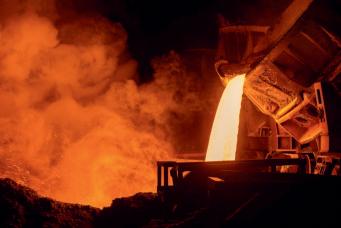





resuming dumping its steel-based products in the US market – the latest being electric vehicles.
The aggressive export of subsidized over-production is the Chinese communist party leadership’s mantra to resuscitate its weakened economy characterized by an ongoing property market slump, declining household spending and a shrinking population, to name some of its woes.
The mood in the US in an election year is not very receptive to China’s aggressive exports, with both the US and Europe keen to reduce their dependence on China, and strengthen their own manufacturing sector and create jobs.
US treasury secretary Janet Yellen, on a recent visit to China, also reportedly conveyed US concerns about China’s overcapacity.
Meanwhile, according to the AISI, the biggest steel suppliers to the US in February 2024 were Canada (537,000 net tons, minus 14% over January), Brazil (506,000 NT, plus 8%), Mexico (328,000 NT, minus 17%), South Korea (185,000 NT, minus 6%), and Taiwan (85,000 NT, plus 38%). �







Sinobras commenced operation at its second long steel rolling mill in December 2023 with a view to providing new types of products to the construction and other industrial markets. The project has cost $204M. In the first part of this two-part feature, Sinobras’ performance prior to the opening of the mill will be analysed, while the second part will focus on the new opportunities provided by the mill.
By Germano Mendes de Paula*SINOBRAS entered the Brazilian long steel industry in 2008. It belongs to Aço Cearense, one of the largest Brazilian importers and distributors of flat steels, and is fully controlled by Vilmar Ferreira. Thus, Sinobras was meant to complement the line of products previously sold by Aço Cearense. Its original configuration consisted of: a) the two charcoal blast furnaces, with a capacity of 175kt/yr and 136kt/yr, which were purchased from Siderúrgica Marabá (Simara) in November 2006. These blast furnaces, installed in Marabá (State of Pará), served as the basis for the construction of the rest of the mill; b) the melt shop, which contains a 40/t EAF, corresponding to a rated capacity of 312kt/yr that was inaugurated in May 2008; c) the 300kt/yr rolling mill started-up in September 2008. The cost of implementing Sinobras was estimated at $350M, including investments in reforestation and working capital (STI, April 2009, p. 17).
Pig iron production rose from 87kt in 2008 to 118kt in 2010, and has remained roughly at this level since then (Graph 1). Currently, Sinobras operates with just the
largest blast furnace. In its first full year of operations in 2009, the company’s crude steel production reached 181kt, equivalent to 58% of its nominal capacity. In 2012, the respective values were 319kt and 102%. In 2016, with capacity already expanded to 380kt/yr, the volume of crude steel totalled 374kt, which meant full capacity.
Sinobras’ rolled production was equivalent to 164kt in 2009 (or 55% of rated capacity). The following year, this increased to 238kt and 79%. In 2016, the respective figures were 310kt and 103%. Thus, the Sinobras rolling mill was operating above nominal capacity in 2016. This justifies the plant having produced 58kt of billets for sale to the market.
Aço Cearense Industrial, a sister company, inaugurated a drawing plant in 2000 in Fortaleza (State of Ceará), prior to Sinobras’ start-up. Sinobras added a drawing plant in 2010. Their combined capacity increased from 60kt/yr to 132kt/yr in 2014. Aço Cearense Industrial also has a flat steel service centre, including the fabrication of welded tubes.
Having filled its installed capacity relatively
quickly, in 2013, Sinobras announced a $200M investment plan, aiming to increase rolled steel capacity from 300kt/yr to 800kt/ yr. This plan also included a shredder, a new power transmission line (with a substation), improvements to the steel shop (to be compatible with the scale of the rolling mill) and an increase in drawn production. The initial intention was to complete this project by mid-2016.
The creditor protection procedure and recent productive performance
However, given the unsatisfactory performance of the Brazilian long steel market, Sinobras’ expansion project ended up being halted, even with the new rolling mill already stored at the mill. More importantly, in May 2017, Aço Cearense group filed a request for judicial reorganisation, due to $545M liabilities. In 2016, the holding company had $483M net revenues and $24M net losses. In December 2016, Sinobras’ net sales reached $326M, with minor $3M net losses, but with $212M liabilities. Therefore, Sinobras finished up being more affected by the financial
* Professor in Economics, Federal University of Uberlândia, Brazil. E-mail: germano@ufu.br

The steel manufacturing assets were purchased in 2007 from POSCO to extend the seller’s existing manufacturing capability. The order comprised of 10,200 cases weighing over 53,000 tons.
The assets for sale arrived after the financial crisis of 2008 and plans for installation where delayed due to market uncertainty. Future plans to expand were further halted with the economic shockwave caused by the COVID-19 pandemic in 2020.
The owners subsequently decided not to expand production and the mainly unused assets, crated and stored as per the OEMs recommendation, are now available for sale.
Two A/C climate-controlled warehouses contain those assets that require a temperature-controlled environment with the remaining assets catalogued and mapped in secure paved outdoor storage.
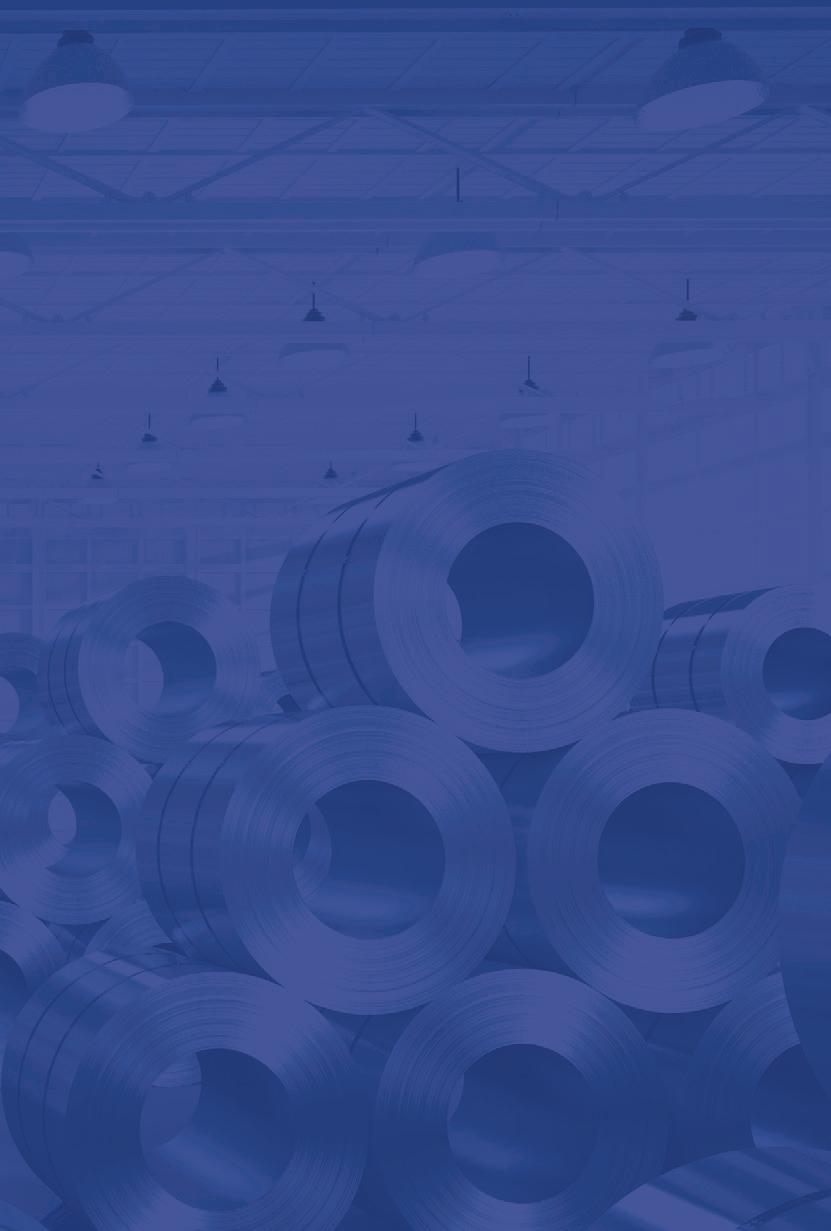

The available assets include but are not limited to:
• STS 4-strand billet caster (2008)
• Rokop 5-strand billet caster (1995)
• Mannesmann DEMAG 2-strand thin slab caster
• Mitsubishi 5-stand 4-high hot strip mill (1998)
• UBE Industries 700,000 TPA hot skin-pass mill (1998)
• 3 Inductotherm 30T induction furnace (2008)
• 2 VAI Fuchs 80T electric arc furnace (2000)
• Nippon Steel Corporation 150T ladle refining furnace (1998)
• 6 Wärtsilä 10.51 MW diesel generator sets (1997)
• 5 Sulzer 10.56 MW diesel generator sets (1994)
• 10 overhead cranes by Hyundai, Samjung and Bando ranging from 12T – 110T
Gordon Brothers is currently accepting offers on the 2 million TPA Flat & Long Steel Production Plant, as well as on individual assets.

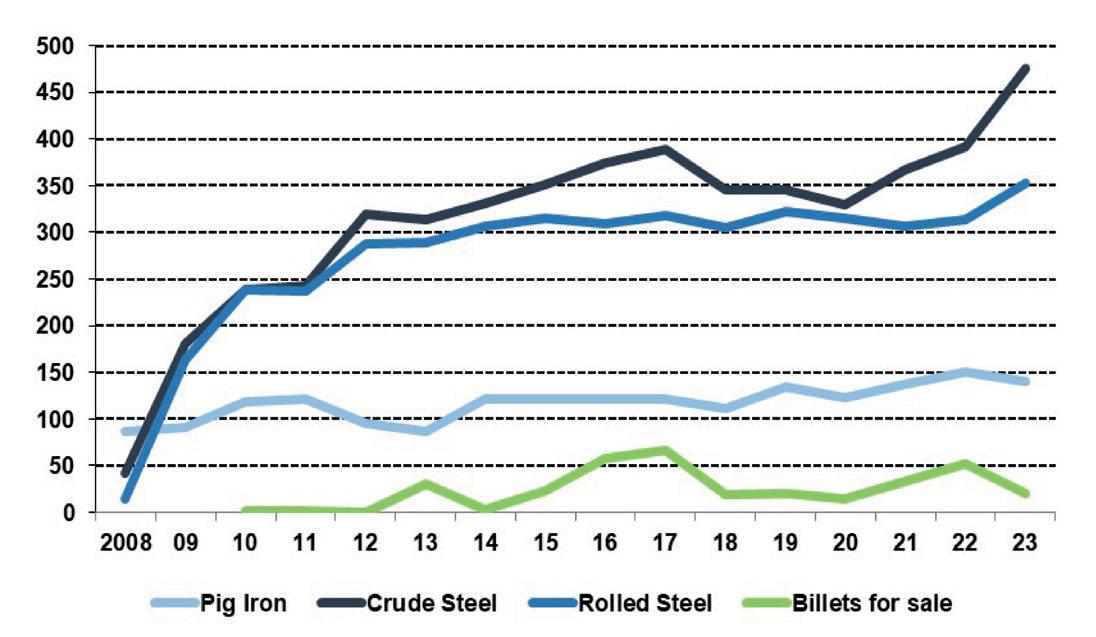
performance of its parent company. It is important to highlight that the creditor protection procedure was finished in October 2022.
As it can be observed in Graph 1, along the period 2017-2023, Sinobras’ pig iron output oscillated around a 130kt/yr plateau, as it had been operating with just one of its blast furnaces. Regarding crude steel production, it diminished from 389kt in 2017 to 345kt in 2018-2019 and even to 330kt in 2020, as a consequence of Covid.


Nevertheless, it increased to 367kt in 2021, 392kt in 2022 and 475kt in 2023, when it produced substantially more billets in order to accumulate some semis for the newcoming rolling mill. It is understood that Sinobras’ melt shop is operating with 75% scrap and 25% liquid pig iron.
Sinobras fabricated roughly 310kt/yr of long products during the period 20172022, which was equivalent to its nominal capacity. Last year, however, it achieved 352kt. This can be considered a good


performance, taking into consideration that Brazilian long steel output (including seamless tubes) decreased from 9.8Mt in 2022 to 9.1Mt in 2021, showing a 7% drop. In addition, Sinobras sold on average 34kt/yr of billets between 2017-2022 and 21kt in 2023.
With the start-up of the rolling mill, Sinobras began a new development phase, as will be examined in the second part of the article, which will appear in the July/ August print edition of the magazine. �
Enhance the Safety, Storage & Efficiency of your logistics with Combilift
Combilift’s range of multidirectional forklifts, pedestrian reach trucks, straddle carriers and container loaders will allow you to maximize the capacity, improve efficiency and enhance the safety of your facility. Contact Us Today
To find out how Combilift can help you unlock every inch of your storage space.
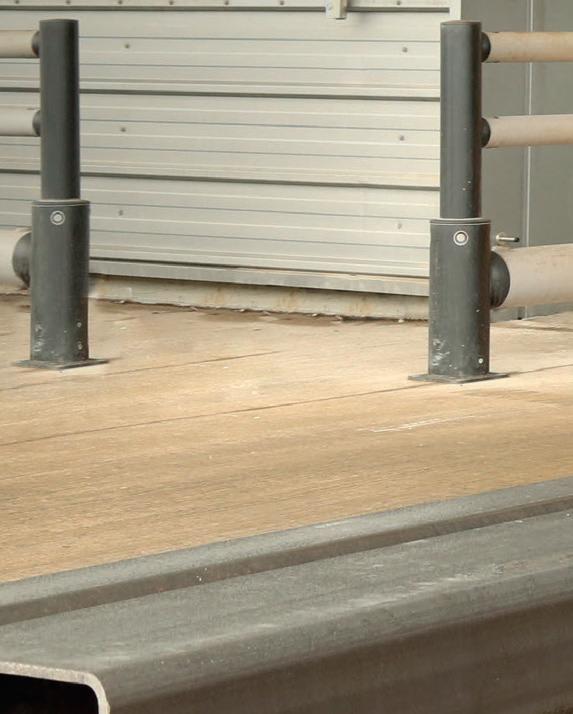











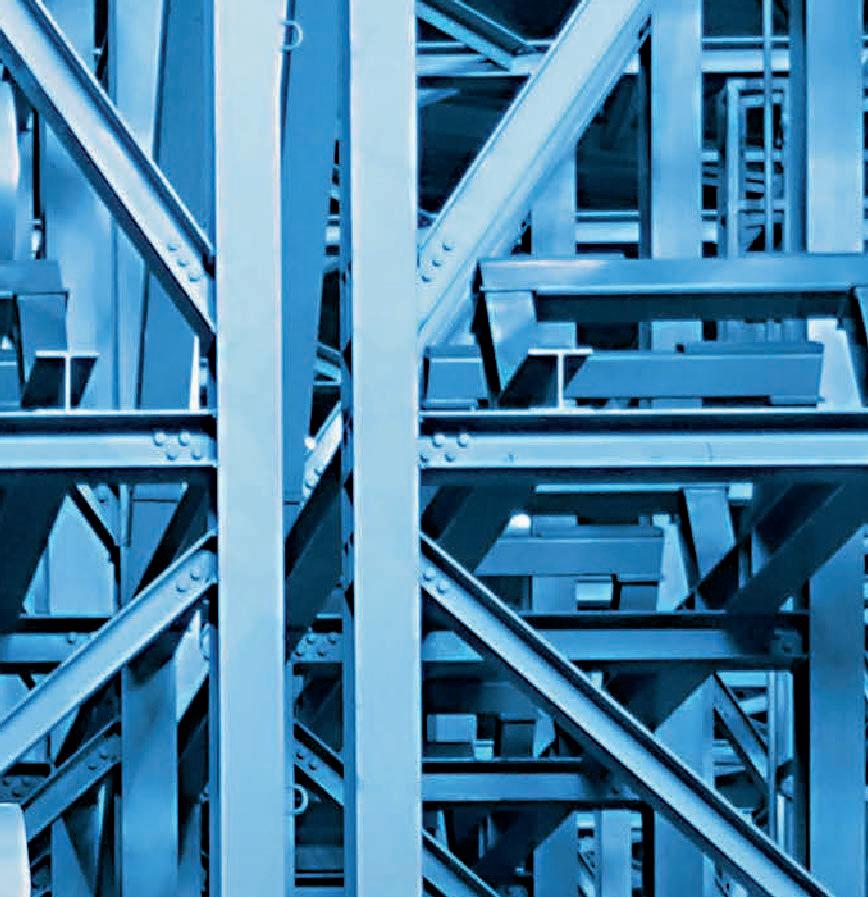






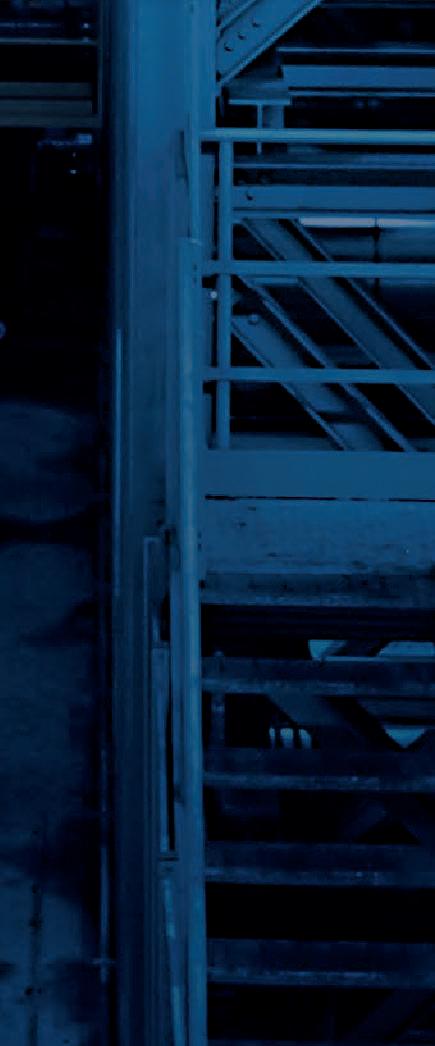



INDIAN producers have been facing tremendous margin pressure due to a slowdown in steel demand since December 2023, as the caretaker government abruptly halted fund releases following the Parliamentary election-led Aachar Sanhita (Moral Code of Conduct). The central government requires permission from the Election Commission of India (ECI) to release funds from the date of announcement of the Parliamentary election (this year on 16 March 2024) to the Oath Taking Ceremony of the next Council of Ministers (by end-June this year). Therefore, the caretaker government avoids releasing funds for any private or public sector projects, resulting in an abnormal delay in stalled projects, including those in the infrastructure or housing sector. Consequently, Indian steel producers estimate the slowdown in domestic steel demand to continue at least until June-end. Domestic steel producers strongly rely on the government’s infrastructure spending and plan their capital outlay accordingly.
Domestic infrastructure projects gain significance as the sector cumulative consumes approximately two-thirds of the overall steel demand, thus exerting a multiplier effect on the country’s economic growth and employment creation.
Announcing the interim Union Budget in February this year, India’s Finance Minister, Nirmala Sitharaman, increased capital expenditure by 11% to INR 11.11 trillion, which is approximately 3.4% of gross domestic product (GDP).
According to the Joint Plant Committee, part of the Indian government, the country’s steel exports rose by 12.7% to reach 6.65Mt from April 2023 to February 2024, compared to 5.9Mt reported in the corresponding period last year. In February alone, India’s outbound shipments of steel surged to 1.03Mt, a 21.2% increase from 850kt reported in January 2024. Domestic steel shipments have skyrocketed since December 2023, following a slackening
Source: Joint Plant Committee, Indian government, *CPLY = Corresponding period last year
*India correspondent, Steel Times International
in local demand. Therefore, overall steel exports recorded a staggering jump of 77.6% since December 2023. However, increasing domestic demand has prompted steel mills to boost supply to local mills between April and November 2023. Not only did exports surge, but also imports witnessed stellar growth during the April 2023 to February 2024 period. A Joint Plant Committee analysis shows India’s steel imports surging by 28.8% since December 2023 but softening to 760kt in February 2024. Despite contracting by 1.3% in February 2024, steel imports recorded a jump of 35.6% to 7.58Mt during the April 2024 to February 2024 period, compared to 5.59Mt reported during the corresponding period last year. Supporting the ‘Aatmanirbhar’ (self-reliance) vision, India’s net steel trade contracted by 930kt during the April 2023 to February 2024 period.
However, analysts called India’s rising exports ‘opportunistic’, which may ease once domestic demand resumes post-
Source:

election. The ongoing slowdown in domestic steel demand may have a longterm impact as projected by the Indian Steel Association (ISA). The Association estimates that overall domestic steel demand will grow by 6.3% to reach 136.97Mt in the financial year (FY)2024-25 (April-March), compared to the 7.5% growth projected at 128.85Mt for the recently ended FY 202324 (April-March) and 119.86Mt reported in FY 2022-23 (April-March).
Domestic steel demand has already been
slowing since December 2023, growing just 6.5% after six months of approximately 16% growth. “While these are early trends, these numbers nonetheless hint at demand remaining soft over the next two quarters as government spending moderates around the election period,” stated Jayant Roy, senior vice president and group head of corporate sector ratings at Icra Ltd. The rating agency estimated that domestic steel consumption growth will slide to 7-8% in FY 2024-25 after three years of double-digit growth, down from approximately 12-13% in FY 2023-24. Concurrently, higher input
costs and soft steel prices will squeeze operating profit margins for producers by 1.10-1.15% in FY 2024-25. Crisil Ltd said in its analysis that about 12-13Mt of new capacity were expected to come on stream between October 2024 and March 2025, aligning production with demand and reducing import dependence.
Major Indian steel producers such as Tata Steel Ltd, Jindal Steel and Power Ltd, JSW Ltd, among private producers, are planning to commence project work on 22Mt of capacity additions in FY 2024-25. Although Jindal Steel and Power is expected to add 6Mt to the existing capacity of around 9.6Mt, Tata Steel is adding 5Mt to 21Mt of its existing capacity. India’s largest steelmaker JSW Steel aims to increase its capacity to 38.5Mt by 2024-25, up from 27.5Mt of domestic capacity currently.
ISA forecasts India’s steel demand to expand by 8-9Mt/yr at least in the next couple of years due to robust capital expenditure on infrastructure development. Infrastructure spending is expected to accelerate, and growth in urban consumption is projected to sustain at least for now. The rising share of investment in the economy, backed by strong capital expenditure outlay by the government and improving private investments is likely to drive India’s steel demand in the future. The stellar growth can be estimated through a 33% acceleration in the budgeted capital expenditure to INR 10 trillion, of which 50% has been allocated for road and railway infrastructure. �
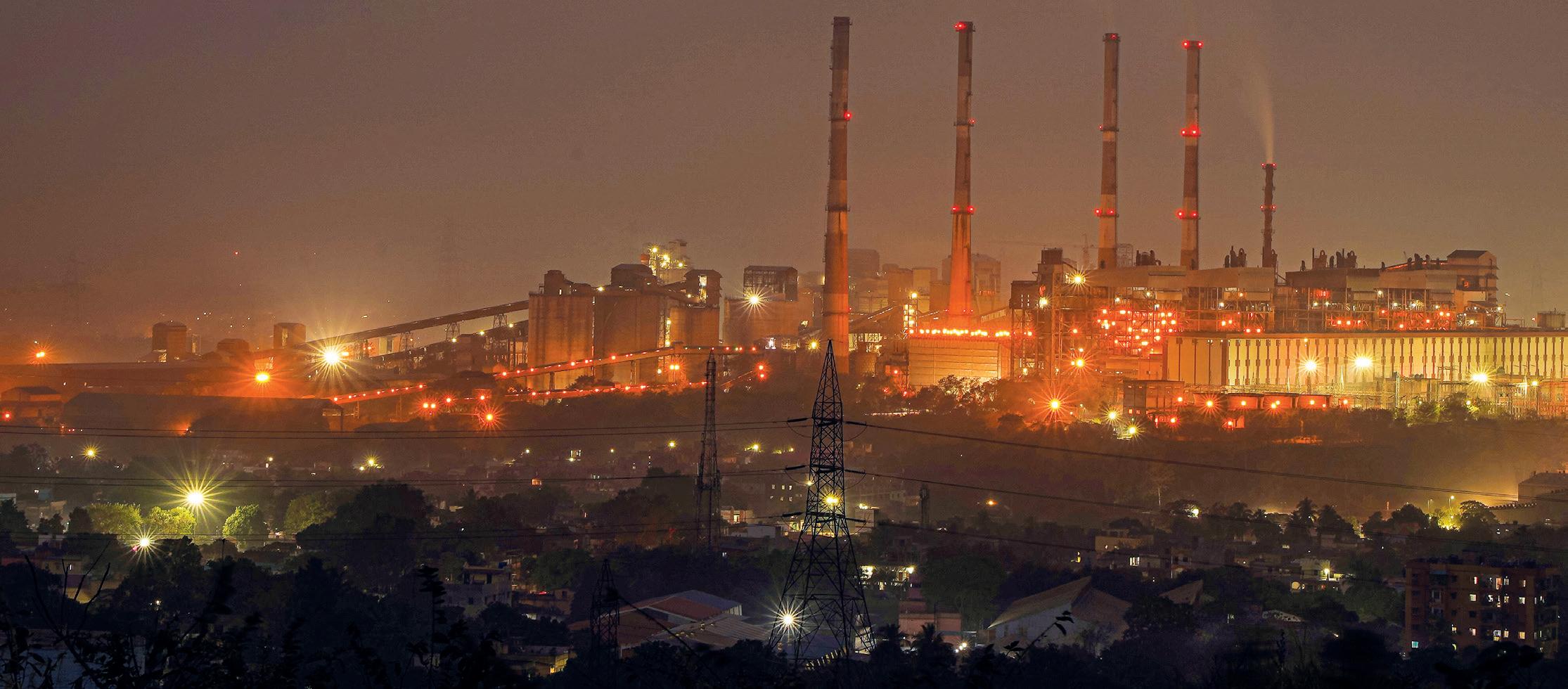





The European Union’s (EU) Clean Border Adjustment Mechanism (CBAM) is a landmark regulatory framework aimed at curbing emissions embedded in imported goods, including steel. By 2026, it will require steel importers to fully measure, report, and pay for these greenhouse gas (GHG) emissions, aligning imported goods with the stringency of the EU’s climate policies. By Urszula Szalkowska*


IN anticipation of CBAM’s full implementation, the first reporting phase has already commenced, with a grace period allowing the use of default emission values until June 2024. Nevertheless, steel producers are urged to prepare for more rigorous emissions reporting in compliance with EU methodology to maintain competitiveness in the EU market. From 2026 onward, importers must procure CBAM certificates at prices reflecting the EU Emissions Trading System (ETS), further incentivizing accurate emissions declarations.
Non-EU importers held to standard CBAM’s inception is a strategic move to address carbon emissions by ensuring that non-EU manufacturers are held to similar GHG-reduction standards as those within the EU. It attempts to level the playing field between domestic and foreign producers and reinforces the EU’s commitment to becoming a carbon-neutral continent by 2050. This mechanism marks a shift from negotiated international environmental regulations towards the EU leveraging its market power to project its climate policies globally. As such, it signifies the maturing and globalization of carbon markets, requiring producers worldwide to adapt to these comprehensive standards.
Prepare now for EU methodology Currently, importers can use the EU
calculation methodology or emissions calculations accepted in countries of origin or default values listed by the European Commission to report embedded emissions. Based on CBAM reports received in January 2024, most importers used the last easiest option, ie, default values. However, as mentioned previously, this type of reporting will no longer be accepted after June 2024.
After a transition period in 2025, the EU calculation methodology and its emissions factors will be required for CBAM reporting in 2026. This means that importers and producers should be already preparing for actual life cycle GHG emissions reporting following the EU methodology to remain competitive in the European market.
Additionally, importers in 2026 will be required to purchase CBAM certificates corresponding to the declared emissions. The price of CBAM certificates will be based on the weekly average price of the EU ETS allowance and expressed in EUR/tonne of CO2 emitted. An independent accredited verifier will need to verify the declaration’s accuracy. Each year, by 31 May, starting in 2026, declarants will surrender CBAM certificates equivalent to their declared and verified embedded emissions. CBAM certificates will not be tradable, but they can be re-purchased by a regulator that issued them.
New importers of iron and steel can register at any time they decide to bring goods covered by CBAM to the EU
*Managing director, European markets, EcoEngineers.

market. Depending on when they become importers, they need to follow the rules applicable in this specific period. For example, until the end of 2025, they need to follow transitional rules; starting in 2026, they must follow full compliance rules.
Importers can claim emissions reductions if a carbon price was paid in the country of origin and deduct this price from the CBAM cost. Details on how the EU will incorporate foreign climate policies into CBAM calculations will be finalized before a definitive rule is entered into force. The European Commission claims that it will consider the position of its international partners. In the meantime, some countries are already deliberating how to accommodate CBAM. For example, China is contemplating including CBAM sectors in its own cap-and-trade scheme, and India is discussing a CO2 tax.
As the CBAM enters into force, foreign companies must navigate the complexity of the system and its timeline to ensure compliance. Understanding these key requirements and the depth of the regulation is crucial for exporters looking to participate in the European markets. �
For more information about CBAM or other EU climate policies and programmes, please contact Urszula Szalkowska at uszalkowska@ ecoengineers.us










and QSP–DUE are the winning Danieli direct-rolling technologies for the most competitive production of long and flat green-steel products.
They are the result of the research and continuous improvement profused over 20 years, along with multi-million dollars of investment.


Their unmatched performances have fueled their success worldwide, thanks to lower resource consumption and carbon emissions, unbeaten OpEx, and outstanding product quality.
So, top technology becomes copied technology, the shortest route for competitors that, abandoning their solutions, now try to imitate MIDA–QLP and QSP–DUE
Equipment and layout may be copied, but experts know that details make the difference. Automation and process solutions are not easy to copy, and this will be the experience of anyone trusting in those imitations.
The competitive advantage for our customers, obtained by field results, is the best defense for our technology – more than court rulings protecting our patents.


Danieli offers the best guarantees for speedy learning curves, steady performances, and now Digital Plants with no men on the floor. Buy the Original.
GIANPIETRO BENEDETTI CHAIRMAN OF THE BOARD OF DIRECTORS




With the EU’s CBAM coming into play this month, importers must ensure that their data is accurate in order to ensure alignment. By
Jonathan Leclercq*ENTERED into force in May 2023, CBAM (Carbon Border Adjustment Mechanism) is a regulation that will initially impact nonEU-based producers of certain industrial materials that export to the EU (iron and steel, aluminium, cement, fertilizers, hydrogen and electricity), and also EUbased importers of these products. CBAM forms part of the Fit for 55 package, the EU’s plan to reduce greenhouse gas (GHG) emissions by at least 55% by 2030 compared to 1990 levels, and become carbon neutral by 2050.

The transitional phase of CBAM began on 1 October 2023. This meant that EU importers of steel, aluminium, cement, fertilizer, hydrogen and electricity had to submit the first required quarterly report detailing the embedded carbon emissions of their imports on 31 January 2024.

received from the operators
• The third-country operators hadn’t taken necessary steps to determine actual emissions
• They opted for the simplest way of reporting (default values were pre-filled in the CBAM transitional registry).
What happens now?
EU importers of products impacted by the EU’s Carbon Border Adjustment Mechanism (CBAM) who have not yet submitted CBAM reports have until 31 July 2024 to do so, otherwise they will face the risk of being fined (€10-50 per tonne of unreported carbon emissions).

What steps do importers need to take to ensure the emissions data they provide to the EU is accurate?
EU importers should perform a screening on the emissions data they received from third-country operators to ensure that it is the actual data determined according to the CBAM greenhouse gas (GHG) accounting principles.
This screening can consist of asking third-country operators for relevant documentation, such as the calculation template and supporting evidence, to ensure its alignment with the CBAM methodology.
There are also other steps that can be taken to ensure quality control for accurate carbon accounting, which include:

However, as the Financial Times recently reported in March, fewer than 10% of 20,000 German companies reported by the deadline earlier this year, according to data collected by Germany’s emissions trading authority. Through our discussions with companies across Europe who are required to report, there are a number of difficulties that importers have experienced with sourcing, and therefore submitting, the actual emissions data corresponding to their imports of products manufactured outside of the EU, which include:
• They’ve had difficulty tracing back to the third-country operator who manufactured the goods
• The third-country operators had difficulties determining the actual emissions according to the new CBAM methodology
• They were not confident in the credibility of emission information they
For those who did submit CBAM reports, the EU made it possible to submit emissions data using default values for the first three quarterly reports. However, for the remaining transitional period – from 1 July 2024 to 31 December 2025 – importers will have to provide actual values (estimated values may still be used with a quantitative limit of up to 20% of the total embedded emissions).

• Verifying data by cross-checking against multiple sources to ensure consistency and accuracy
• Performing audit to assess data quality and identify potential discrepancies

• Validating the accuracy of calculations and measurements.
From 2026 (after the transitional period has ended, and when companies will start having to pay the carbon tax based on the emissions of their imports), the emissions data of imported goods will need to be verified by a third-party before being submitted to the European Commission. However, there are many benefits to ensuring that you procure accurate emissions data before this. This would:
• Ensure that third-country operators are ready for the definitive period so the risk of non-compliance (and therefore, fines) is minimized
*Senior manager, decarbonization and sustainability, DNV


• Provide an accurate estimation of financial exposure when the tax will apply – precise emissions data will allow this
• Enable companies to take informed decisions regarding business and supply chain decarbonization strategies.
In general, what work needs to be undertaken to ensure your CBAM compliance strategy works for your business and its supply chain?
CBAM reporting can add workload and costs to importers and manufacturers. However, ensuring that you are on top of emissions reporting and other sustainability measures that are increasingly being required to track and report on throughout the value chain, is a worthy investment in the long run.



In particular, to ensure that CBAM reporting requirements are met, EU-based steel importers can seek the help of an adviser to:
• Map suppliers and source accurate emissions information
• Assist in the collection of emissions data at the installation level
• Assess the quality of emissions data received from suppliers
• Provide an accurate evaluation of the financial impact of CBAM.
In turn, producers impacted by CBAM that are based outside of the EU can benefit from external advice to:
• Support their CBAM readiness and the determination of the actual embedded emissions
• Build and manage elements of a wider decarbonization strategy and lowcarbon initiatives. �




Blast furnace steelmaking is on the way out. Fact. But it’s not going to go quietly and it won’t happen overnight. Taking its place will be the electric arc furnace combined with direct reduction technology and, of course, scrap; but with 85% of the world’s iron ore either low or medium grade, and EAFs more at home with high grade raw materials, things might get messy. In the second of three ad-libbed interviews with senior executives from Primetals Technologies, Matthew Moggridge* talks to Gerald Wimmer** about the electric smelter and its place in the steel industry of tomorrow.
A few weeks ago I sat down in front of the television with a view to watching (all the way through) The Fugitive, a movie starring Tommy Lee Jones and Harrison Ford about a man – Dr Bruce Kimble, played by Ford – who is on the run having been found guilty of a murder he didn’t commit. Oddly, perhaps, it got me thinking about blast furnaces. I know, I’m weird, I’ll accept that, but I found myself thinking that the humble BF (as it is known in steelmaking circles) is on the run. After decades of good service in integrated steel mills around the world, the blast furnace is suddenly the bad
guy, the rabbit caught in the headlights, the cause of all environmental ills, and now they’re being hunted down and dismantled. Well, not quite and not yet. As we all know, the blast furnace will be around for some time to come and they’re still being built in China, India, parts of South East Asia and elsewhere; some are being relined at great cost and there are plenty of new technologies being developed, such as CCUS, designed to make the BF more environmentally friendly than is currently the case.
Odder still, perhaps, is that people as
* Editor, Steel Times International
clued up as Philip Bell, head of the Steel Manufacturers Association (SMA) in the USA – an association representing North American EAF manufacturers – has said that there will always be room for the blast furnace in modern steelmaking. Is he right? Only time will tell, but there are plenty of people around, like Caroline Ashley, director of the UK-based climate watchdog SteelWatch, who would fundamentally disagree.
While the media perception is that blast furnaces are well and truly on the way out and are not only being hunted into
** Vice president, converter steelmaking and a member of Primetals Technologies’ Green Steel Team



extinction, but also replaced by EAFs, the truth is yes, they are on a back foot but are far from finished.
New technologies
Gerald Wimmer, who is responsible for converter steelmaking at Primetals Technologies, based in Linz, Austria, believes that while we will see less and less blast furnaces as steelmakers continue with the challenge of tackling the climate emergency head on with a variety of new technologies designed to reduce carbon emissions, there will still be plenty of Basic oxygen furnaces – or BOFs – in circulation as the steel industry continues with the serious work of reducing CO2 emissions.
“The bad guy in the room is the blast furnace,” Wimmer told me, explaining how they use only carbon to make the full reduction, “so we definitely have to do something” but he disputes the need to do away with the BOF. “I think it is too simple that the BOF has to go away,” he said.
These are interesting times for the global steel industry. The blast furnace is on a back foot, so is the use of coking coal and
sinter in iron making as it has now been proved – not that there was any doubt –that hydrogen can be used instead, thanks first and foremost to Swedish ingenuity and companies such as SSAB who pioneered the successful HYBRIT process; and, more recently, H2 Green Steel, also from Sweden, who is pushing ahead with the development of a dedicated, purpose-built, greenfield hydrogen steelmaking facility in Boden, northern Sweden, which will go live in 2025.
What about blast oxygen furnaces? “I agree there will not be big growth for BOF, but I am convinced that we will still see BOFs in the next decades; but to understand this we must go a step back and look at total CO2 emissions. I am happy to see that our steel industry is serious about reducing emissions and when we go into a bit of detail as to where the emissions come from, we see they come mainly from the blast furnace.” Wimmer explained.
“Without the blast furnace today, there is no hot metal to feed the BOF converters,” said Wimmer. “But in the future we see two things, one is that we have different iron ores and that mother nature provides the resources we have, but she doesn’t care too much which process we have in mind, Looking now into green steelmaking using hydrogen for reduction – like H2GS for example – an electric arc furnace is needed for melting because direct reduction is never doing the melting or the separation of metal and slag – the blast furnace does, direct reduction will not; so this is done in the electric arc furnace and it works, but only if you have the right iron ore. High grade iron ores as we call them, meaning iron ores with a low mineral fraction and a high iron content, result in low slag volume in the EAF. Operation with such material is fun, fast, and profitable. But Australian iron ore is not high grade, it is low grade and further beneficiation is difficult and expensive; the blast furnace is taking this iron ore and is happy to melt and separate the slag and – also very important – it’s going to create slag that is suitable for the cement industry, avoiding any landfilling of by-products.”
Wimmer asserts that if you think the steel industry is the bad guy in terms of CO2 emissions, wait until you meet the ‘cement guys’ – they’re even worse! “If we are, CO2wise, as the iron and steel industry, the bad
guys in the room, then the cement guys are even worse, as the cement industry is the largest industrial emitter of CO2 in the world with even larger emissions than the steel industry,” he said and it needs this CO2-free secondary material to reduce its emissions. “Also, in future, if we shut down the blast furnace how will we process this iron ore, there is not enough high grade iron ore to switch all the blast furnaces to electric arc furnaces.”
Turning the global steel industry into an EAF-centric environment – which, ultimately, is the plan – would, on the face of it, be bad news for Australian mining companies because EAFs need a higher grade of iron ore, which rules out the stuff coming out of antipodean mines. In other words, simply getting rid of all blast furnaces will turn the spotlight on the availability of the right raw materials in terms of grade.
In Australia, these are worrying times because if – or when – the big shift to EAFs happens then there will be a noticeable shift in purchasing patterns as steelmakers look to buy the highergrade ores demanded by EAF operators. This would leave the Aussies with the Chinese as their main customer and such a scenario has prompted industry observers to question whether it is possible to make green steel down under, offering more value generation instead of simply shipping iron ore out to where the processing takes place.
“We all know that scrap is the most sustainable material and scrap recycling, luckily, in the Western world is already as high as 90%, so you can only increase the amount of scrap from recycling maybe by three or four per cent. Basically, we must accept that scrap availability is limited,” Wimmer said.
“So think wisely what you do with steel: make smaller cars, make less cars, make a smaller bridge, build a house out of wood, because we do not have enough steel, we’re simply not ready for this; so we’ll still make steel out of iron ore in the future and there are basically two ways: either we keep the blast furnace and combine it with carbon capture and storage (CCS) technology – which is not ideal for steel at the moment – or we switch to direct reduction using natural gas or, in the long term, hydrogen, the latter being
With over 50 years in the Steel Industry, we have a wide variety of solutions to keep your mill rolling.
allow for quick and accurate pass changes
· Honours existing mill attachment points and guide base, no machining on your stands required
· Made from stainless steel and speci cally tailored to your mill ensuring perfect t, operation and longevity

Our roller entry guides keep your product on the pass
· Single point, centralized adjustment during operation
· 2, 3 and 4 roller con gurations
· Rigid, stainless steel construction
· Broad size range
Maximize your mill speed while meeting your quenching requirements on all bar sizes. Not just controlled cooling, but correct cooling
· Fewer surface defects and better scale control
· Available in Box, Trough and Restbar-mounted con gurations
the dominant strategy at the moment,” Wimmer said.
Green steelmaking – the ‘gold standard’
And when we talk about hydrogen steelmaking we are talking about the likes of SSAB/HYBRIT, H2 Green Steel and SALCOS, and are in the process of developing production technologies that rely upon hydrogen as a reductant, not coal, and, therefore, are regarded as the ‘gold standard’ of green steelmaking. But when we consider the raw materials, in particular Australian iron ore, then clearly direct reduction is the solution; but, says Wimmer, the EAF will not fit. Why? Because EAFs demand higher grade iron ore and not the lower grades mined in Australia. “You can build an electric arc furnace technically, you can run it with an incredible amount of slag, but it’s not fun, it’s very slow, it’s very expensive, and the metallurgical process is difficult to handle,” he said.
With the blast furnace on the way out, Wimmer firmly believes that there are two process options available to steelmakers. One is the electric arc furnace (fine if you have access to high grade iron ore). The second is a two-step process based on a new piece of equipment known as the Smelter. The existence of the electric smelter means that the basic oxygen furnace (BOF) can detach itself from the mother ship (the blast furnace) and continue its good work refining hot metal into crude steel. The smelter, therefore, would breathe new life not only into BOFs but also low-grade iron ores.
Looking at it in the cold light of day, then, blast furnaces are fine with low grade and high-grade iron ores. The blast furnace is really the best option for steelmaking and would continue to be blasting away if there was no such thing as a climate emergency. The BF represents the best way to make steel and if other methods are on the table, then operators are going to have to change their raw material. Electric arc furnaces require higher grade iron ore to operate efficiently and the cost equation is too high for some existing integrated steelmakers. Enter the electric smelter! An alternative to the blast furnace that offers users a twostep process in collaboration with the BOF. In short, it will keep the BOF process alive. Wimmer says that raw materials decide the process route. When it comes to electric steelmaking, operators pay the premium

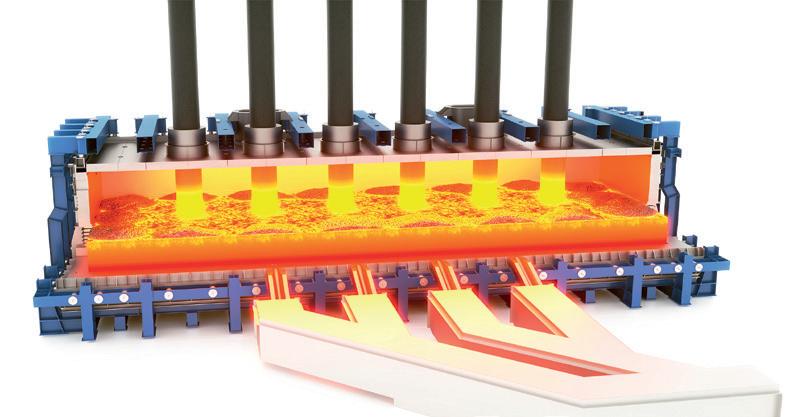
for high grade pellets because they need them. Integrated mills on the other hand often claim that their strength is based on smart purchasing, they buy low-grade raw materials but it’s super cheap. The key takeaway here is that the electric smelter will allow integrated mills to continue purchasing low-grade ores…and all from a piece of equipment that could be described as a ‘simple EAF’ but with the added bonus of enabling sophisticated metallurgy to continue in the BOF, hence the twostep process. In essence, the smelter is a dedicated furnace which is simply melting the iron, reducing and adjusting the slag and separating metal from slag and then straight to the BOF. Wimmer says that the chief advantage for existing operators is they can keep their steel plant largely intact with all the quality certification and ‘the well-aligned processes where the BOF and the secondary metallurgy and the caster fit perfectly to each other’. “That’s a big advantage of this route and that’s why it is especially of interest for existing integrated plants with big BOFs and a big investment in secondary metallurgy and casting equipment,” he said.
The big question, of course, is how long before the electric smelter becomes reality? The answer? Not long. “We have announced that we have signed contracts with voestalpine and with Australian mining company FMG to build a demo plant here in Linz, Austria, for our new green ironmaking process – an innovative combination of our HYFOR direct reduction technology and a smelter.
HYFOR stands for hydrogen-based fineore reduction and uses 100% hydrogen to reliably reduce iron ore fines. The project’s partners for the first HYFOR demonstration plant were Primetals Technologies, K1-MET, Montanuniversität Leoben and voestalpine Stahl Donawitz all of whom, it is claimed, have gained valuable experience from operating a pilot plant at the voestalpine Donawitz site. This plant produces several hundred kg of DRI in discontinuous operation mode since two years ago.
This new ironmaking process is claimed to take things a ‘major step further’ and on an industrial scale. DRI fines leave the HYFOR plant and head directly into the smelter where a product similar to pig iron is produced and can be further processed in the traditional converter process. The plan is to build a demonstration plant in Linz that will produce up to three tonnes of pig iron per hour in a continuous process, all fully based on green hydrogen.
The fact that low-grade and mediumgrade ores account for around 85% of the world’s iron ore supply gives you some idea of the importance of developing the electric smelter especially where CO2-free reduction is concerned, offering clear advantages in terms of global competition for raw material, says Thomas Buergler, CEO of K1MET’s metallurgical competence centre and partner of the HYFOR-Smelter project.
Primetals is also working with South Korean steel giant POSCO with whom it has a long history using its FINEX technology. FINEX is fluidized bed technology and, says Wimmer, direct reduction, which ‘is already quite modern’. However, FINEX uses a coal-fired furnace to melt the raw material




BIGGER.
Superior Machine has joined the Woodings’ group creating the most capable hot metal equipment supplier group in North America. Offering the combined knowledge, engineering, manufacturing, and construction expertise for all your equipment needs.
Wherever hot metal is produced, you will find equipment from Woodings, Superior Machine, and


Munroe operating at the highest level in the most demanding conditions. Our products and professional installation services reduce downtime and extend campaign cycles.
We are better together. Let us show you. woodings.com
We can provide you with more value than ever before from concept to installation, service to replacement, our size, scope, and experience gives us a unique ability to help you increase productivity and solve problems.



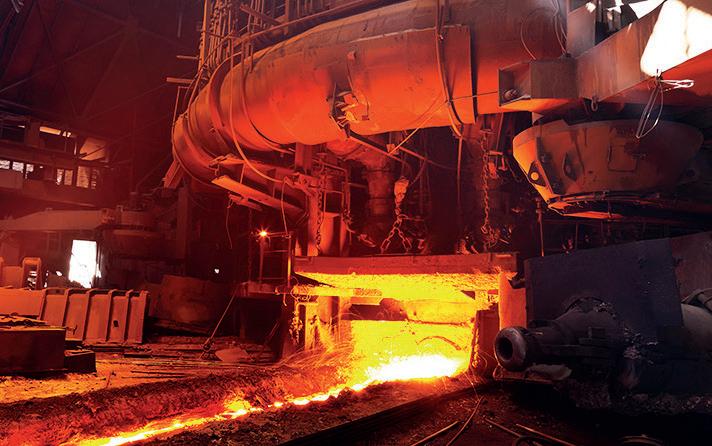






‘and this, of course, does not fit the green world’, so the target of the HYREX project, says Wimmer, is to use fluidized bed technology, modify it for hydrogen and combine it with an electric smelter. In essence, HYREX is fluidized bed technology from FINEX with an electric smelter, he said.
The HYREX project with POSCO is already an industrial-sized plant with a 30 tonnes per hour capacity. “The engineering is progressing; funding, permitting and financing is always a topic so with both projects, the HYFOR-Smelter and HYREX, we’re somewhere in the middle. Total costs will become clearer and we hope we’ll be able to start construction work for both projects this year,” Wimmer said.
Have we nailed green steelmaking?
I asked Wimmer whether he thought the steel industry had nailed green steelmaking. “Effectively, we’ve risen to the challenge,” he said. “There are always the forerunners who start it and then some of them fade away. It takes a long time and I expect the journey to be long with setbacks along the track,” he added.
I suggested that he was very positive towards current technologies that exist to make BF steelmaking a greener proposition. I mentioned CCUS, which I have always viewed, perhaps wrongly, as a go-to technology for BFs to make them greener than they would otherwise be. “I wouldn’t go that far in the first step,” he said. “I can see a lot of steps that could be done, lots of ideas for the blast furnace.” He said that the BF has a huge role to play and that the big picture is, of course, hydrogen-based direct reduction, but it would be foolish to
bet only on that card because ‘soon we will be at the point where everyone will look forward to when the first plants are running and decide to wait for the aforementioned ‘gold standard’ to arrive, knowing that they have a very big installed base’. “I think this is not the right way,” he said.
The importance of ‘multi-tasking’ Wimmer believes in the need for ‘multitasking’ but he is aware that the industry finds it difficult to handle a lot of projects in parallel. “But I think that is what is necessary. We need to optimize the existing routes if the integrated mills still have a reasonable time of operation. We cannot keep them as they are, knowing that there is still some potential to improve,” he said.
Wimmer said that the BOF is a furnace with a lot of energy and that energy can be used to melt scrap. “So that’s why today you always put a bit of scrap in it. The more scrap that goes in a BOF, the less hot metal is needed so my steel is ‘greener’ at the end,” he said. “Scrap rate is important to make the existing production route greener. It’s not possible to go 100% in a BOF, but by increasing the scrap rate by 10% will reduce CO2 emissions by 10% and this can be implemented in a short time and steelmakers can benefit from the investment within a year.”
Current optimization measures which show small improvements are important. “And then we see the other projects,” he said. “We’re coming back to the smelter. I’ve told you we have these two horses in the race and now we are brave enough to go for a first full industrial plant with 2.5Mt of annual production – 3D engineering
already started, but focusing on this and not taking the opportunities in other areas for our climate is not okay.”
So what can we take away? First, that 85% of the world’s iron ore supply is of low-tomedium grade and that harnessing it on an industrial scale for CO2-free reduction offers big advantages in terms of global competition for raw materials.
Second, we know that the blast furnace is on the run, but it’s not going to disappear overnight. In fact, they are still being built and relined as I write this in places like China, India and South East Asia.
Third, the plan is to replace blast furnaces with electric arc furnaces (EAFs) but there are problems. EAFs are not ideal for use with low-to-medium grade iron ores which, bearing in mind that 85% of the world’s iron ore supply is of that category –particularly from mines in Australia – could be problematic.
The solution, therefore, might be the electric smelter, which can produce hot metal and then transfer it to the BOF, a piece of equipment that would otherwise be redundant in a world populated only by EAFs.
What goes into the electric smelter? Direct reduced material which comes out the other end as hot metal, fluxes to adjust the slag, carbon which is needed for final reduction and the BOF. The slag from the smelter is similar to what is produced in the blast furnace and, therefore, it can be used as aggregate in the cement industry. “Nobody knows what to do with EAF slag,” said Wimmer. “Hot metal goes to the BOF and for the BOF guys there are minor changes in carbon and silicon levels only. Torpedo cars transfer hot metal from the smelter to the BOF like today’s transfers of hot metal from the BF.”
The bigger point is that the steel industry cannot afford to sit around waiting for ‘the gold standard’ of green steelmaking –hydrogen steelmaking of the HYBRIT and H2 Green Steel variety – to arrive on its doorstep and do nothing between now and then.
As Wimmer points out, ‘multi-tasking’ is important in the drive to reduce global emissions, be it CCUS or electric smelting or whatever. In short, steelmakers should embrace the technologies under development if it means reducing emissions. �

Here to stay, or on the way out? The debate persists surrounding the blast furnace make-up of North America’s steel industry. By Myra Pinkham*
DESPITE the inroads that electric arc furnace (EAF) steelmakers have made over the past few decades, many industry observers say that there will always be a need for blast furnaces in the United States. How much of a need, however, will depend upon the ability of the EAFs to penetrate the few remaining blast furnace end-use markets, particularly the production of exposed automotive sheet.
Another question is what impact the proposed acquisition of US Steel by Nippon Steel will have upon the US steel industry in general, including blast furnace steelmaking.
“US blast furnace production has gone past the tipping point,” Felix Bello, a North American steel analyst for Fastmarkets, maintained, noting that currently there are
only about 10-12 blast furnaces operating in the United States compared with over a hundred in the 1970s.
This is contrary to what is occurring in some other regions of the world. In fact, Philip Bell, president of the Steel Manufacturers Association (SMA) observed that globally 70% of crude steel is produced using blast furnaces.
However, Philip Gibbs, a senior equity research analyst for KeyBanc Capital Markets, observed that US blast furnace crude steel output is nearly half of what it was in 2000, with their share of steel production falling to about 25% from about 53%. He said that while there is going to be some volatility year-on-year, it is likely that this trend will continue, especially with all the new US EAF capacity
*North America correspondent, Steel Times International
coming online.
In fact, with steel produced by blast furnaces being used in fewer end-use markets – mainly automotive, but also to some degree for appliances, tinplate, and some electrical steels – John Anton, director of S&P Global Market Intelligence’s steel service, said that at best their demand going forward will be the status quo
While North American blast furnaces lead the world in their carbon footprints, Josh Spoores, a principal steel analyst for CRU, pointed out that they tend to emit more carbon than EAFs, which isn’t desirable given the industry’s push for greater sustainability. He said that is why the blast furnace share is not only reducing in the US, but in Canada as well, with both ArcelorMittal Dofasco and




Algoma converting blast furnaces to EAFs. He, however, noted that another major Canadian steelmaker – Stelco – is, at least for the time being, looking to stick with blast furnaces.
Kevin Dempsey, president and chief executive officer of the American Iron and Steel Institute (AISI) pointed out that all the steel producers in the US, including US Steel and Cleveland-Cliffs – its two remaining integrated steel mills – operate EAFs and are constantly improving in terms of technology and production processes.
“There always needs to be a balance between EAFs and traditional integrated mills,” Dempsey said, maintaining that you can’t sustain a growing economy solely with recycled steel. “There is always a market demand for virgin metallic content,” he explained.
Also, Dempsey pointed out that not only
is the scrap consumption rate for US blast furnace steelmaking operations about 25%
is the scrap consumption rate for US blast furnace steelmaking operations about 25% compared with 10-15% elsewhere in the world, but – at least currently – traditional US blast furnace steel mills tend to be fed by domestically sourced iron ore pellets, as opposed to the carbon dioxide-intensive sintered iron ore used in China, India, and other countries.
“American steelmakers have made investments to increase the use of direct reduced iron (DRI) and hot-briquetted iron (HBI) which can lower emissions for both integrated blast furnace-basic oxygen furnace and EAF steel mills, which relies heavily on natural gas and renewable energy, and that helps them to lower the carbon emissions in their steelmaking process,’’ he pointed out.
will always be a role for blast furnace
But while Dempsey admits that there will always be a role for blast furnace steelmaking in the US to produce virgin iron ore units, the SMA’s Bell said he believes that the EAF share of US steel output will continue to grow, and that the integrated steelmakers’ share will continue to decline.
continue to grow, and that the integrated in their financial performance. Also, he said environmental trends as renewable energy
One reason, according to Fastmarkets’ Bello, is that an EAF’s small batch production flexibility delivers significantly higher efficiencies that are clearly reflected in their financial performance. Also, he said that the EAF’s alignment with such current environmental trends as renewable energy and carbon emissions reduction, further strengthens its business case.
“Blast furnace steelmakers have also been improving their energy efficiency and carbon footprint,” Bell noted, “but not at the same time pace and rate as EAFs.”
In fact, Bell pointed out that the US Department of Energy (DOE) projected in its recent decarbonization roadmap that by 2050, over 90% of the steel produced in the US will be done so by some route other than integrated steel production. “That could be EAF steelmaking, a combination of EAF and DRI, hydrogen-based steelmaking, or some other technology we are yet to see,” he noted.
However, CRU’s Spoores noted that there are some dynamics that could influence the resilience of US integrated steelmakers, including the ability to access competitively priced hydrogen, and for carbon capture and sequestration technologies to be put into place.
Becky Hites, president of Steel-Insights LLC, pointed out that Cleveland-Cliffs is in the midst of early efforts to add hydrogen-
based steelmaking at its Middletown, Ohio, plant and, once it is commercialized, could eventually roll out that technology across its steelmaking facilities.
But while blast furnaces have served the US industry, society, and economy for well over 100 years, Bello said he believes that it is time for it to pass the torch, stating, “Such a phase-out would further affirm that the steel industry, on the back of EAF technology, has caught up and is aligned with social and environmental goals, and should be the primary route for future steelmaking.”
At the same time, Spoores pointed out that the latest models of EAFs that have recently come online, or are expected to do so shortly, are capable of producing the most technologically advanced steel grades that they have ever produced including some that are typically only produced via blast furnaces.
“It is a myth [that] EAFs can’t make automotive grade steels,” the SMA’s Bell said, which is why several leading automotive steel producers in the US and elsewhere in the world have already started converting to EAFs and several traditional EAF steelmakers are looking to sell some steels that could not only be used in automotive applications, but exposed automotive. He went on to say, “We’ve proven that we don’t need a blast furnace to make the advanced high strength steels used by the automakers and, therefore, we are changing the market as we speak.”
The question, however, is whether the automakers are comfortable using EAF steel for exposed automotive, S&P Global’s Anton said. He said, “The fact that there are still blast furnaces operating indicates that they haven’t reached that goal yet because if the EAFs can meet the required quality requirements, it is hard – but not impossible – to imagine the continued need for blast furnaces.”
SMA’s Bell, however, said that he believes there will always be a place for integrated steel production – for steel made from virgin iron units. “But I think that the sustainability needs of our planet and the process technologies that are underway and already commercially proven are showing that integrated steel production will undergo a massive change over the next 20 to 30 years.”
But both Cleveland-Cliffs and US Steel are currently looking to continue to operate their blast furnaces, albeit to different

degrees. While US Steel – especially after its acquisition of Big River Steel (which Hites calls its best strategic decision in the past decade) – has incorporated its ‘best of both’ business strategy incorporating both blast furnaces and EAFs, Gibbs said that, at least for the time being, Cliffs is planning to continue to run their current blast furnace ‘fleet’.
While Cliffs does have some EAFs, Spoores noted that they are largely used to make plate, stainless steel and electrical steel as opposed to hot roll. He, however, said that he believes that within the next five years or so the company could potentially seriously consider replacing one of its blast furnaces with an EAF.
Also, in late March, Cliffs was selected to negotiate an award for up to $575 million in funds for two projects from the DOE’s Industrial Demonstrations Programme, which is funded by the bipartisan IIJA infrastructure bill and the Inflation Reduction Act (IRA). If it gets those awards, Cliffs will replace the existing blast furnace at its Middletown (Ohio) Works with a hydrogen-ready DRI plant and two electric melting furnaces (EMFs), and would replace two of its natural gas-fired high-temperature slab reheat furnaces at its Butler (PA) works with four electrified induction slab reheat furnaces. It is uncertain what the timeline for those
projects will be if approved.
Not only did US Steel shutdown the last blast furnace at its Granite City mill late last year, but Gibbs said that it is possible that its Mon Valley Works in Pennsylvania could be next to be idled given that over the past several years the steelmaker has indicated that it isn’t as much of a strategic asset for them anymore.
One big question is what impact the proposed acquisition of US Steel by Nippon Steel could have upon the US steel market, and what will happen if it fails to go through.
As far as the origin of this proposed acquisition, S&P Global’s Anton said that US Steel hadn’t necessarily been looking to be purchased, but rather, after doing a good job of turning itself around in recent years, making itself a very valuable company, it received several seemingly unsolicited offers.
CRU’s Spoores noted that it was only after US Steel publicly rejected one of those offers – the one from ClevelandCliffs (largely due to the potential antitrust issues) – that it invited others to submit bids and underwent a strategic review that resulted in the steelmaker announcing in December its plan to be acquired by Nippon Steel, which already has a US presence through its AM/NS Calvert joint venture with ArcelorMittal in Calvert, Ala., and its
Wheeling Nippon joint venture in West Virginia.
That deal, if successful, would make the combined company the third largest steel producer in the world.
But even though Nippon Steel has a lot to offer both financially and technologically, there has been a lot of resistance to this combination. For example, Miriam Falk, a senior steel analyst for Fastmarkets, noted that the United Steelworkers’ (USW) union has cited concerns about job security, transparency, and enforceability of labour agreements despite Nippon’s promises to uphold existing labour agreements.
Also, Anton pointed out that a lot of the resistance has been political in nature, especially with this being a presidential election year and both Joe Biden and Donald Trump questioning whether ‘US’ Steel should be acquired by a foreign company, even with Japan being a close US ally.
“I don’t know how valid the fear of national defence implications of foreign ownership are,” Spoores said, observing that should there be a national emergency, the US could easily nationalize the company’s steelmaking assets.
Nippon Steel, which has traditionally had a lot of expertise in the auto sector, has a lot to gain from this merger, Gibbs said, given its stated goal to increase its global steelmaking capacity, something that is hard for them to do in Asia, but the USbased foreign-owned automakers might be more willing to do business with Nippon if it has a US presence.
It remains to be seen what US Steel will do if the Nippon deal falls through. Most industry observers said that they believe that antitrust implications will still prevent Cleveland-Cliffs from acquiring it and that if Nippon is prevented from buying US Steel, no other foreign company would be able to do so. “US Steel could just be stuck running what they have,” Gibbs said.
The proposed acquisition, however, is not expected to affect the US balance between blast furnace and EAF market share.
“If EAFs are able to bring the quality of their steel to a level that the automakers will accept EAF-produced sheet for exposed applications, the blast furnace steelmakers are in deep trouble,” Anton said. “But if that doesn’t happen the integrated steelmakers will continue to be in good shape because of their auto-related demand.” �

Following an ‘exceptionally strong’ 2023, the North American structural steel market is facing slight pullbacks. By Myra Pinkham*
The US structural steel market is somewhat softer than it had been in 2023, which, according to many industry observers, had been an exceptionally strong year.
“It remains in a pretty good place,” Philip Bell, president of the Steel Manufacturers Association (SMA) declared. Brian Raff, vice president of market development for the American Institute of Steel Construction (AISC), agreed, but he said at the same time that the market has started to see some headwinds.
“Even though the market is in a healthy place, we are starting to see things slow down just a little bit in certain construction sectors” said Raff, and this is happening at a time when US structural steel fabricator backlogs (of around 20 weeks) remain extremely healthy; so if something happens, they will still have structural steel inventories that they need to work down.
This, according to Scott Hazelton, director and an analyst with S&P Global Market Intelligence’s construction service, comes on the back of high interest rates and labour issues, as most of the US’ private construction sectors are just ‘poking
along.’ He noted that at the same time, helped by some recently passed federal legislation, there is some good news related to public works – particularly infrastructure construction. “But that might not be enough to offset what is happening in the rest of the market.”
Felix Bello, a Fastmarkets North American steel analyst, said that one reason why there has been a slight decline in US structural steel shipments from a year ago is the lag in time from when construction projects are announced and when structural steel is actually ordered.
Another factor, Bello pointed out, is that a number of anticipated construction projects haven’t been triggered quite yet. This, he said, is at least partly because most of the funds from such recently passed legislation as the IIJA bipartisan infrastructure bill, the Inflation Reduction Act (IRA) and CHIPS and Science Act haven’t been released yet.
But Philip Gibbs, an equity research analyst at KeyBanc Capital Markets, said a lot of it is also attributable to the interest rate environment, noting that not only have
*North America correspondent, Steel Times International
interest rates picked up meaningfully over the past year, but that with ‘sticky inflation’ it has become increasingly apparent that interest rates won’t be going down quickly. “We knew that once the interest rates started to be felt, that would slowdown private non-residential construction activity,” and, therefore, structural steel demand.
“It held in there for as long as it could with the desire to complete projects that have been started,” Gibbs said, but given that structural steel tends to be mostly used in the front end of projects, structural steel demand will likely be slightly down this year, depending on what happens with new project activity.
But, according to Alexandra Anderson, a CRU senior steel analyst, up to this point US non-residential construction activity continues to be okay. “It isn’t amazing or terrible, but rather strong enough to keep the structural steel market stable.”
The reports on non-residential construction spending, however, have been somewhat mixed, Ken Simonson, chief economist for Associated General


Contractors, pointed out. For example, while the US Census Bureau has reported very modest month-on-month declines over the past few months, including a 0.2% decrease for March – year-on-year private non-residential construction spending was up 9.6%. Also, he noted that there has been a lot of variation by sector.
He also observed that it is a somewhat different story for public works construction spending, which was up 0.8% month-onmonth and 18% year-on-year in March.
“We are expecting to see continued growth in bridge building,” AISC’s Raff said, noting that some of the monies appropriated by the IIJA is starting to flow to the states, which will give them
an opportunity to further fulfil their infrastructure plans.
“Also, the IRA, which promotes the use of sustainably produced steel in building structures, bodes well for the structural steel industry,” SMA’s Bell said, especially given that structural steel is primarily produced by electric arc furnace (EAF) steelmakers. “Also, there is an overall need for low carbon emissions steel given the General Services Administration’s new strict buy clean statutes.”
But it is difficult to predict where the private non-residential construction market will go from here, especially with the recent volatility in the American Institute of Architecture (AIA) architectural billings
index, which, after being the least negative that it had been in nearly a year at 49.5 points in February, fell to 43.6 points in March – the lowest it had been since December 2020.
Kermit Baker, AIA’s chief economist, agreed that concerns about when the Federal Reserve will start cutting interest rates is one of the biggest impediments to companies moving ahead with projects.
“It isn’t just that new work isn’t coming in, but also that some existing work is disappearing,” he said, adding that abandoned projects are more of a concern than those that have just been delayed.
While overall US non-residential construction real growth is likely to be up about 11% this year – largely due to the strength in the infrastructure and manufacturing sectors – S&P Global’s Hazelton said he is expecting it to decline about 2.4% next year, although that depends upon several yet uncertain factors, including the impact of the upcoming presidential and Congressional elections and the dynamics of the various construction sectors.
In fact, Alex Carrick, ConstructConnect’s chief economist, questioned whether the boom in starts of mega projects (those with a $1 billion or more price tag) might be past its peak.
As far as private non-residential construction goes, Simonson said

the biggest growth has been from the manufacturing facilities and data centres. He noted that spending on manufacturing plants – by far the largest sector (accounting for about 20% of all non-residential construction) – was up 0.1% month-on-month in March and about 32% year-on-year, largely on the back of investments in semiconductor chip, electric vehicle and EV battery production facilities coming in the response to the CHIPS Act and the IRA. According to the Census Bureau, construction spending on computer, electronics and electrical manufacturing plants are up 45% yearon-year with investments in transportation equipment plants up about 35%.
Also, with the push for such ‘big data’ trends such as artificial intelligence, cybersecurity, cryptocurrency and virtual reality, there is a need for servers, and therefore, data centres. But since the Census Bureau combines spending for data centres with that for office building, which is a relatively weak construction sector given its low occupancy rates (only 60% by some estimates), it is hard to determine the growth rates for those two categories. But, said Hazelton, given that combined ‘office’ sector spending was up about 1% year-on-year and that the traditional office component is down drastically, data centre investment is probably up about 10-20%. Meanwhile, warehouse construction,

which experienced a once in a generation expansion during the tail end of the pandemic and, which, according to John Anton, director, and analyst with S&P Global Market Intelligence’s steel service, accounted for about 20% of structural steel use, has come down drastically.
AGC’s Simonson said that is because of the huge amount of new warehouse space hitting the market at the same time as many retailers are struggling and aren’t looking to store as many items as they had been. In fact, according to Fastmarkets’ Bello, not only has Amazon cancelled some warehouse construction projects it had in the pipeline, it has even been closing or sub-leasing some of its existing warehouse space.
Meanwhile, there hasn’t been any major changes in structural steel supply, which CRU’s Anderson said remains largely in balance with demand and with domestic mill lead times only about three to four weeks, no one is stockpiling steel.
Also, with some uncertainty about future pricing, Anderson said there hasn’t been a big push to risk buying imported steel.
“There isn’t a reason to do so,” she said. “The demand can be met domestically within a reasonable timeframe.”
SMA’s Bell said that with US steelmakers currently operating at about 70-75% capacity utilization, there is plenty of room for them to ramp up their production to meet any increases in demand.
Gibbs said that there are some other factors that have limited import penetration, including the fact that beams don’t tend to travel very well, so companies tend to source them locally if they can. “Also, recent ‘Buy America’ mandates have been another limiting factor’’, he added.
Structural steel prices have been flat largely in line with scrap prices, which, Anton pointed out, have been declining since their 2022 peak. After coming down $80 a short ton in late March, structural steel prices flattened out again in April. Still, Anton said he believes they could continue to face slight downward pressure through much of the year.
Bello agreed, stating, “We don’t expect the bottom to fall out, but there will likely be more price declines before we see more clear signs of federal fund disbursements and their impact upon construction activity.”
In the meantime, AISC’s Raff said he expected to see a marginal pullback in the US structural steel market with people being a little more cautious about their investments. �
























SPONSOR





As the industry seeks cleaner alternatives to traditional steelmaking processes, hydrogen produced using electricity from renewable sources offers the tantalizing promise of carbon neutrality.
By Bruno Touzo* and Sangram Mohpatra**THE transition to steel production powered by green hydrogen will be driven by exciting technological advancements, including the development of new refractories. Innovative processes like direct reduction (DRI) using hydrogen, electrolysis-based iron production, and hydrogen injection into blast furnaces, are among the cutting-edge approaches being explored.
However, despite its potential, the journey towards green steel powered by zero-emission hydrogen involves significant challenges. One concern is the availability and cost of green hydrogen at scale.
While green hydrogen production is on the rise, its widespread adoption in heavy industries like steel remains constrained by infrastructure and production costs. Additionally, the technical complexities associated with transitioning existing steel plants to hydrogen-based processes pose significant challenges. Addressing these challenges needs collaborative efforts, policy support, and continued innovation –up and down the supply chain.
Playing a vital role, Calderys is developing adapted refractory solutions for its customers, and is going even further by partnering with a number of laboratories and research projects.
Beyond environmental imperatives, the transition to green steel also holds great economic promise. As sustainability becomes increasingly ingrained in consumer preferences and regulatory frameworks worldwide, demand for low-carbon steel will increase. Companies that embrace hydrogen-based steelmaking could stand to gain a competitive edge, not only by reducing their carbon footprint but also by tapping into new markets and securing long-term sustainability. What’s more, the





emergence of carbon pricing mechanisms incentivizes the adoption of green steel technologies, including hydrogen.
Policymakers and governments play a pivotal role in supporting the transition with incentives, favourable regulations, and investments in research and infrastructure. Collaboration between ruling bodies, such as the EU, industry protagonists and stakeholders, and research institutions and universities, is essential to accelerate innovation, scale up deployment, and drive down costs.
International co-operation and knowledge sharing can expedite progress and ensure a smooth transition to a sustainable steel industry powered by green hydrogen.
In the quest for a sustainable future, the role of green hydrogen in enabling the transition to green steel is exciting. As well as mitigating carbon emissions, there are economic opportunities, including
*Global vice president, innovation, and technology.
technological innovations. There are challenges, but the collective resolve of stakeholders worldwide to embrace hydrogen as a key enabler of green steel production signals a promising trajectory towards a carbon-neutral future. As we navigate the demands of the 21st century, harnessing hydrogen offers hope, and a path towards a more sustainable steel industry with a more secure energy supply. Iron and steel demand is rising for many reasons, not least because of the increase in urbanization and industrial expansion, which in turn drives the construction of infrastructure. Additionally, as developing countries grow wealthier, the demand for personal and public transportation increases – and the automotive and manufacturing sectors rely heavily on steel. Economic growth, particularly in emerging markets, is pushing demand, and technological advancements in steel are leading to new applications, which also boosts
**Marketing and technical development manager – global DRI projects and refractory solutions.


consumption.
The iron and steel industry accounts for around 8% of the global CO2* footprint. If companies and nations are to make meaningful progress towards lowering emissions, iron and steel production powered by coal and natural gas must be
re-engineered for zero-carbon, sustainable alternatives.
Hydrogen is produced using industrial electrolysis. For hydrogen production to be green, electrolysis must be powered by electricity from renewable sources, such as wind, wave, and solar.
The EU push for green steel production Green hydrogen is a key constituent of the EU’s plan to speed up the green transition and promote massive investment in renewable energy in the region. As well as increasing Europe’s energy security, green hydrogen is important in the EU’s push for net zero CO2 emissions. The target is to achieve a 55% reduction of CO2 emissions by 2030, compared to levels measured in 1990.
Steelmakers are progressively adopting hydrogen and natural gas-based technologies as alternatives to their traditional blast furnace and basic oxygen furnace route. The two most promising hydrogen-based technologies are: injection of hydrogen into existing blast furnaces, and hydrogen and natural gas-based direct reduction of iron ore, coupled with an electric melting furnace.
However, introducing green hydrogen as a fuel source in furnaces and other stages of the iron and steelmaking process isn’t completely straightforward, and significant engineering challenges need to be addressed, as well as the cost and


reliability of production. For a start, the process is energy-intensive, and the supply of renewable electricity must be costeffective, consistent, and reliable. Hydrogen also requires more energy to compress than natural gas and, as hydrogen is the smallest and lightest of the elements, it is difficult to store and transport without leakage, and it can react to metals used in plant equipment, causing corrosion.
Designing refractory linings for iron and steelmaking processes using hydrogen and natural gas is also challenging because of the high diffusivity of H2 in the refractory material, and the reactivity of hydrogen with silica and iron oxide from the refractory at high temperature, which, with the increase in H2 concentrations, decreases the physico-chemical properties and the load-bearing capacities.
Refractory companies play a crucial role in assisting the iron and steel industry in reducing CO2 emissions due to their significant impact on the efficiency and environmental performance of steelmaking processes. By developing and supplying advanced refractory solutions, Calderys’ products help improve the energy efficiency of steel production, leading to reduced CO2 emissions per ton of steel produced. Additionally, innovative refractory materials can enable the adoption of alternative, lower-carbon iron and steel production methods, such as open slag bath furnace OSBF.
Below are some of the hydrogen research projects in which Calderys is actively involved, and which are co-funded by the EU.
Calderys’ role in driving the hydrogen revolution HYDREAMS is an innovation project also co-financed by the EU, and co-ordinated by French firm UGITECH, part of the Swiss Steel Group.
The project’s stated objective is the decarbonization of thermal processes for steel reheating and heat treatment by means of clean hydrogen oxyfuel combustion. The process will also improve the energy-efficiency of the thermal treatments, and simultaneously cut nitrogen oxide (NOx) emissions. It is expected that successful completion of the HYDREAMS project will lead to investment decisions for deployment of green hydrogen reheating furnaces in at least five steel plants in Europe.
As a key partner in the HYDREAMS project, Calderys will develop innovative and tailored refractory solutions to enable steelmakers to optimize their energy usage, reduce emissions, and enhance overall efficiency in all stages of steel production.
TWINGHY is a project partially funded by the EU to test hydrogen as a fuel to replace natural gas in reheating furnaces. The project kicked-off in the summer of 2023 and is scheduled to conclude in 2027.
Based at the CELSA Group plant in Barcelona, Spain, the project is evaluating and demonstrating an advanced heat transfer process, utilizing hybrid burners in order to increase the introduction of hydrogen for direct combustion with oxygen. Key activities include H2/O2 combustion in rolling mill furnaces, trials with new H2 burners, and assessment in terms of product quality, safety, environmental, and effects on refractories.
The process is being controlled by a digital twin of the furnace, incorporating machine learning. Hence the name: (digital) TWIN for Green HYdrogen.
Calderys is the only refractory maker chosen to participate in this project, and its team of experts is studying how modifications to the furnace affect the refractory lining. Based on these findings, Calderys is adapting refractories, or will develop new refractories, suitable for the working conditions of furnaces burning mixes of natural gas, hydrogen, and oxygen. At this stage in the project, refractories are currently being tested by RWTH Aachen University. Design of the new burners is complete, as is design of the plant modification for hydrogen integration, and the planned trials with hydrogen.
Also in Spain, Calderys is supplying equipment, refractories, and expertise to steel plant manufacturer, Sarralle, to put into operation the world’s first ladle

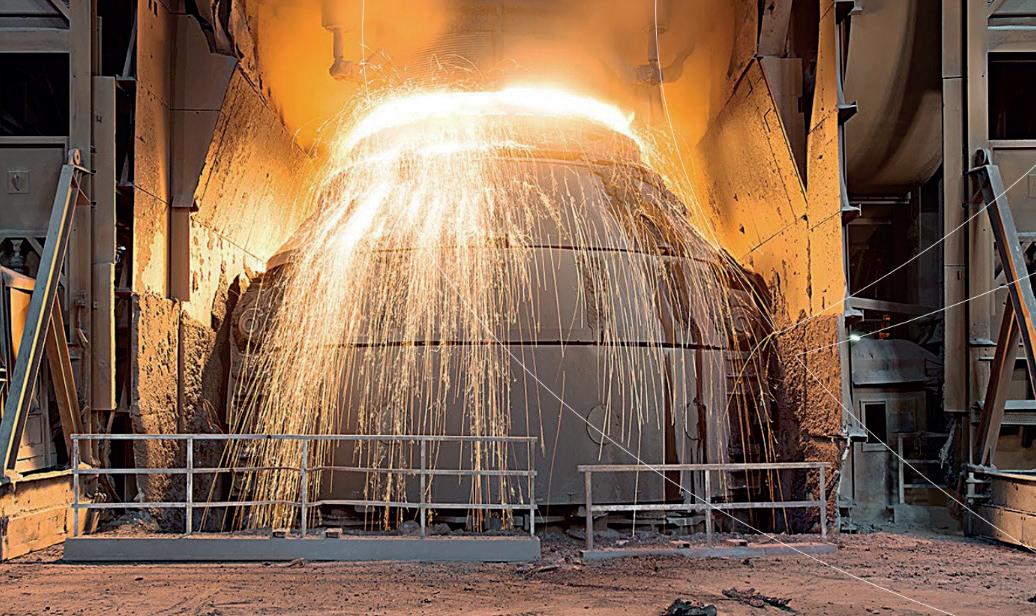
preheating station running on 100% green hydrogen as fuel.
The purpose of this project is to improve the operation of the existing ladle preheater and to replace the natural gas as fuel with green hydrogen, reducing CO2 emissions to a minimum. Additionally, thanks to the installed oxycombustion burner technology, NOx emissions have been reduced to near zero as well. Using 100% green hydrogen as fuel, the different heating/drying curves have been satisfactorily reproduced and the required temperatures for ladle casting have been reached, confirming a homogeneous heating of the refractory.
Calderys is going direct
Hydrogen is increasingly being used in the Direct Reduced Iron (DRI) process as a clean
and efficient alternative to natural gas or coal, a process that has a very real potential to help iron and steel industries become carbon neutral.
Calderys is an experienced player in supplying refractory solutions, engineering, and installation services to new DRI projects, as well as revamping and relining existing units. The DRI process involves reducing iron oxides (usually in the form of iron ore pellets or lump ore) to metallic iron without melting.
In the process, hydrogen acts as a reducing agent, reacting with the iron oxides to produce metallic iron and water as by-products. This reduction reaction is endothermic and occurs at elevated temperatures typically ranging from 800°C to 1000°C.
This reaction forms the basis of the direct reduction process, where hydrogen serves as the primary reducing agent.
Hydrogen as an energy source
Hydrogen also serves as an energy source in the DRI process. The heat required for the reduction reaction is often provided by burning hydrogen. This ensures that the process remains energy-efficient and environmentally friendly, as hydrogen combustion produces only water vapour as a by-product.
Calderys’ experts have carried out a full turnkey DRI project, including design, engineering, material supply, relining and installation. A number of technical challenges encountered during the relining and installations were resolved, making the project a success.
Compared to traditional reducing agents like coal or natural gas, hydrogen offers environmental benefits. When hydrogen is used as the reducing agent, there is minimal or no emission of greenhouse gasses or pollutants such as CO2, CO, and SOx, which are typically associated with the use of fossil fuels.
This makes hydrogen-based DRI processes more environmentally sustainable, and aligns with efforts to reduce carbon emissions in steel production.
green shift continues
The transition to more environmentally friendly furnaces and processes fuelled by hydrogen marks a significant milestone in the iron and steel industry’s journey towards sustainability. Led in Europe by initiatives like TWINGHY and HYDREAMS, and supported by collaborative efforts with innovative partners, including Calderys, the roadmap to decarbonization is becoming more defined. Through the adoption of cutting-edge refractory solutions and tapping into the potential of green hydrogen, steel manufacturers can not only dramatically reduce their carbon emissions but also improve cost efficiency and competitiveness. Thanks to continuous advancements in research and development, alongside co-operative ventures spanning industries and geographies, the vision of a low-carbon future for iron and steel production is becoming a reality. �
*McKinsey and Company

ONE day the war will be over. And Ukraine, as an integral part of the European steel industry, will contribute to the benefit of both European and global industry stakeholders. Rebuilding the Ukrainian steel industry will create opportunities for all involved.
In our opinion, Ukraine has the potential to be:
• a large supplier of DR-grade feed, an in-demand product, of which there is great uncertainty relating to its potential supply in the future;
• a supplier of low carbon HBI, (beneficial for EAF producers that could be faced with a scrap shortage in the next few years);
• a supplier of environmentally-friendly steel products.
First of all, Ukraine is well-suited for the development of projects to produce high quality iron ore products for DRI production. Ukraine has one of the largest global reserves of magnetite ores (5 billion
tons), which are suitable for beneficiation to Fe content of 68-70%. These products will be in demand in the next few years, due to a number of incoming DRI facility projects. In this way, Ukraine will help the global industry in its green transition.
Ukrainian companies have already announced several potential projects aimed at producing DR-grade feed. For example, Metinvest hopes to upgrade beneficiation
facilities and ensure the production of 19Mt of high-quality concentrate and 7.5Mt of DR-pellets.
For Ferrexpo, the production of DR-pellets is a strategic direction and the company is committed to its goals. The company will be ready to focus 20-25% of its output in 2030-2035 on DR-feed when the market needs such volumes.
ArcelorMittal Kryvyi Rih announced a

In the future, the Ukrainian steel industry will be ‘green’ and focused on the domestic market, says Stanislav Zinchenko*.

Ukrainian steelmakers have already announced a number of projects that will allow them to successfully decarbonize. But no-one will invest in Ukraine until the war is over.
Metinvest is studying the possibility of building two DRI modules (with capacities of 2.5Mt each) and two electric arc furnaces at Zaporizhstal, instead of an open-hearth-furnace. On the basis of Kametsteel, which now produces square billets and rebar, it’s possible to carry out
10 years ago. Investments in rebuilding must be effective. So, steelmaking capacities in Ukraine should match volumes, that steelmakers can integrate into existing value chains, to avoid excess capacities. We believe that by 2030 the volume of steelmaking capacities in Ukraine will be lower – about 15Mt.
An output of 12Mt of steel, which is half of the pre-war levels, will ensure 80% of capacity utilization. With an expected domestic consumption of 5Mt, export

project to build a pelletizer with a capacity of 5Mt. The project was frozen as a result of the war. But we believe that this is a promising direction and this project will be a priority for the company after the end of the war.
Black Iron is a Canadian start-up aiming to produce 4 to 8Mt of high-quality concentrate in Ukraine. The project was also suspended due to the war. But when the war is over, this project can be resumed. In our view, Ukraine has the potential to supply 20-25Mt of merchant DR-feed and provide up to 14% of new market demand till 2035. The facilities of Ukrainian iron ore companies are flexible and will allow for the increase of DRI production of DR-feed when market conditions are suitable.
Supplier of low carbon HBI and steel products
Ukraine will join the European emissions trading system in the future and accepts ambitious climate goals. Today, the Ukrainian ETS format is being actively developed. It means that local steelmakers will have to follow the same path as European colleagues.
the reincarnation of Azovstal with the construction of slab casting and bloom casting for the production of plates and structural products. And, steel production may be carried out on an electric arc furnace with HBI as the main part of metallics.
ArcelorMittal Kryvyi Rih has not yet announced specific projects, but it is analyzing the possibility to partially switch from integrated production to the EAF route. This coincides with our independent vision. The plant can use the experience of the parent company by mastering the DRIEAF route.
OECD countries imported 6.2Mt of HBI in 2022 with Russia as the major supplier with 27% of total OECD import. Ukraine has good capabilities for producing pink hydrogen using cheap nuclear energy. So, Ukraine has the ability to become a major exporter of environmentally friendly HBI to OECD countries, replacing supplies from Russia.
Currently, the steel industry of Ukraine consists of only six plants with a total steelmaking capacity of 17.8Mt, compared with 12 plants and 42Mt of capacities just
supplies from Ukraine could reach 7Mt. This is two times lower than the pre-war level, when exports accounted for 80% of total steel production.
Low-carbon steel has already been produced in Ukraine, with up to 1Mt at the Interpipe Steel plant, that was built using state-of-the-art technologies. But taking into account announced decarbonization projects, we estimate the likely production of 6Mt of low-carbon steel, or 50% of total output till 2035. It will contribute to the global combat against climate change. The volume of CO2 emissions will be able to remain at the level of last year, despite the almost doubling of output.
Ukraine will cease to be an exporter of pig iron, as a result of CBAM, but will be able to contribute as a supplier of lowcarbon HBI.
So, the future of Ukraine is in low-carbon production, and is focused on the domestic market. It is a beautiful picture. Today it could be called a dream. For the dream to become a reality, the war must end. Another important condition is access to financing systems for low-carbon projects, which is critical for businesses from a country that is currently struggling to survive. �

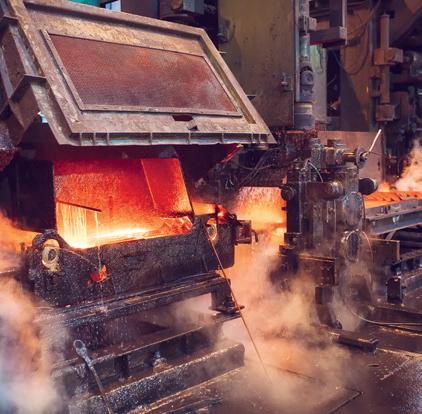

Coal petrography, a microscopic technique used to determine a coal’s rank, enables the analysis of coal formulation, which in turn, predicts the quality of the resultant coke. By B Ghosh1*, B K Sahoo1, B Chakraborty1 and A K Varma2
THE coking behaviour of coal is a significant factor in the selection of coal for metallurgical use and in other industries. The carbonization behaviour mainly depends on the properties of coal rank (i.e. coal type from peat to anthracite), petrography, composition, ultimate composition and rheology. Coal petrography has become a useful technique to establish the formulation of a blend of coals to predict the quality of the resultant coke. It is generally established that a blend containing optimal reactive components produces a coke of maximum strength. The coking properties of coal not only depend on the composition of the macerals (analogous to the use of the term ‘mineral’ in rock) but also on the way in which these are distributed to form preferential associations of microlithotypes (the microscopic distribution of macerals).
The properties of India’s indigenous coking coal, such as the Crucible Swelling Number (CSN), and vitrinite (the shiny mineral in coal) content can be improved by washing using wet media at of a specific gravity from 1.40 to 1.30. The density of the resultant ash content falls from 1.40 to 1.30, but the coal yield is reduced. A proximate analysis which shows the
percentages by weight of fixed carbon, volatiles, ash yield, and moisture content in the coal shows that the yield of volatile matter varies from 20.4% to 30.8%, fixed carbon from 52.2% to 68.8%, and fuel ratio from 2.16 to 3.28. It is concluded that the washed coal sample has fallen into the category of bituminous to super bituminous coal.
The relationship between the plastic range of the coal with the development of the petrographic caking index (PCI) is influenced by the content of micro constituents (vitrinite+ 1.3 liptinite + 0.50 inertinite)* H/C and is significant, with an R2 value of 0.90. The relationship is polynomial, and here the hydrogen content is attributed to the plastic range of the coal. The relationships between the microlithotype coke strength index, MCSI (Vitrite + Clarite+0.9* Vitrinertite +0.9 *Vitrinertoliptite) and CSR, CRI, carbon content and R0max, O/C ratio and H/C ratio, O/S ratio and the plastic range and O/S ratio and CRI have a good correlation. The MCSR (Microlithtype coke strength ratio) and MCRI (microlithotype coke reactivity index) relationship provides good correlations with the Coke Reactivity Index (CRI) and with Coke Strength after Reaction (CSR).
In an upcoming paper, the distribution of microlithotype macerals in coal samples will be studied and correlated with the coal properties and coke quality. The distribution of bi-maceral and tri-macerals microlithotypes (vitrinertite, duroclarite and clarodurite) in coal samples play an important role in coke quality. Inter-growth of vitrinite and inertinite as vitrinertite microlithotype indicate a significant role in coke quality. Therefore, maceral and microlithotype distribution analyses are important in determining the caking property for coke quality.
The relationship between the plastic range of coal with the proposed petrographic caking index, (PCI) has been developed. The distribution of mono, bi and tri- maceralic in coal has influenced the coke cold strength (M40 and M10 indices) as well as hot strength properties (CRI and CSR). The microlithotype coke strength index (MCSI) relationship has been linked to the Coke Reactivity Index (CRI) and separately Coke Strength after Reaction (CSR).
The full paper is to be published in the next digital issue of Steel Times International �
1. Coal Carbonization Group, Research & Development Centre for Iron & Steel, SAIL, Ranchi, Jharkhand, Pin-834002, India.
2 Coal Geology and Organic Petrology Laboratory, Department of Applied Geology, IIT, Indian School of Mines (ISM), Dhanbad 826004, India.
*Corresponding author: B Ghosh: bablu.ghosh@sail.in



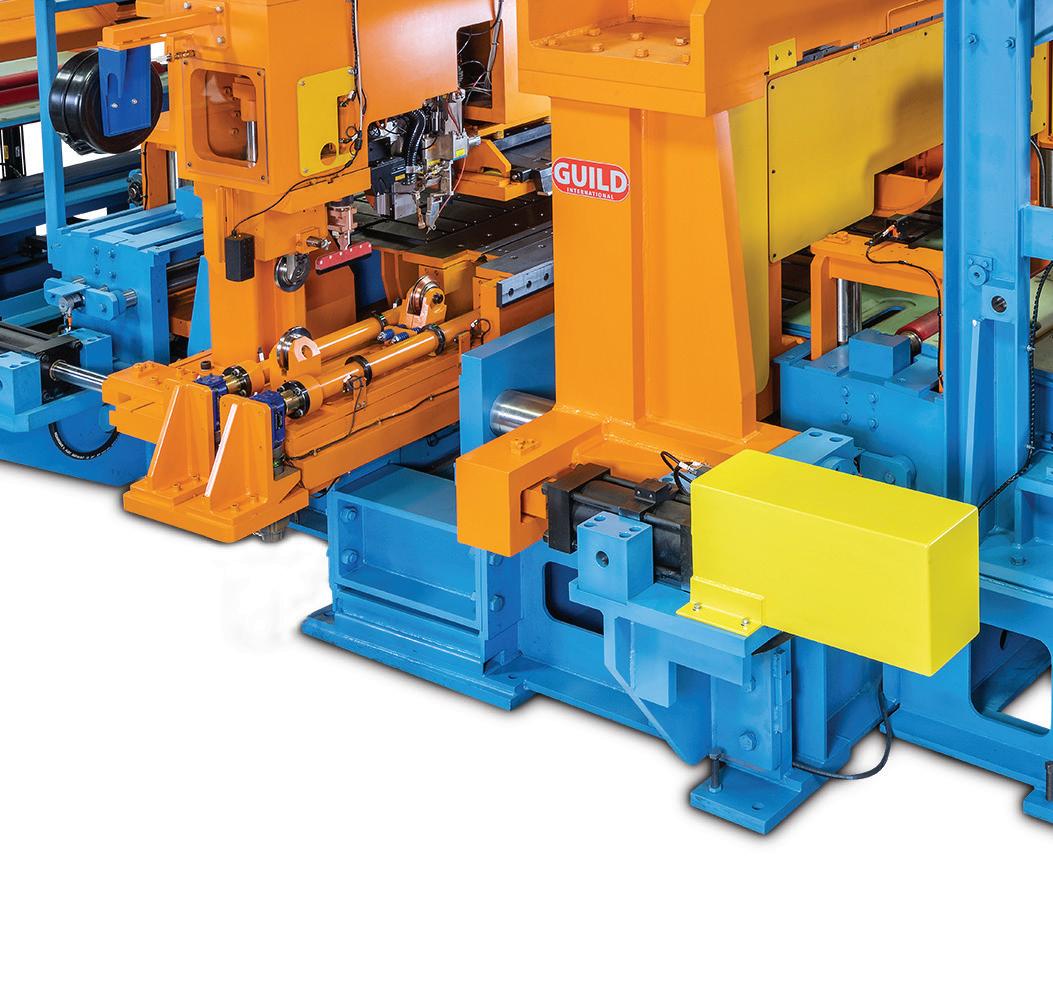

For more information, visit our website at www.guildint.com or call +1.440.232.5887
As one of the largest grinding wheel producers globally, Weiler Abrasives is focused on addressing customers’ challenges, and increasing productivity. By Inja Škrinjar*
1. How are things going at Weiler Abrasives? Is the steel industry keeping you busy?
Weiler Abrasives is one of the largest grinding wheel producers globally, with a very good reputation among many foundries and some of the largest steel rolling mills in the world. Since the steel industry is currently growing, we are also following the demand and providing the best possible technical expertise and abrasive solutions to our customers and continuously working on upgrading our products based on ever-changing customer needs. Products for the steel industry are one of our main focuses. Due to that, a lot of our technical experts are busy with developing high-quality grinding wheels.
2. What is your view on the current state of the global steel industry?
The global steel industry is still in the growing trend due to higher construction activities and manufacturing output in all main industries, like automotive, military, and aviation. Also, infrastructure projects, particularly in developing economies, drive demand for steel. Initiatives such as urbanization, transportation, and renewable energy infrastructure contribute to the demand for steel products.
3. In which sector of the steel industry does Weiler Abrasives mostly conduct its business?
From the perspective of the steel industry, we are focused on metal conditioning, cold roll mills, hot roll mills and foundries. Additionally, Weiler Abrasives has a full line of metal fabrication, cutting, grinding, surface preparation, and deburring products to fully support downstream production activities that are a significant portion of the industry.
4. Where in the world are you busiest at present?
Our main focus areas are currently North
America, South America, India, Turkey, Scandinavia and the DACH region.

5. Where does Weiler Abrasives stand on the aluminium versus steel argument?
Weiler Abrasives mainly focuses on steel industries with rolling mill and foundry grinding products, but also supports the aluminium industry with metal fabrication, surface preparation, and deburring products. In my opinion, both will be vital materials as we move into the future to support the many different facets of the global economy, from structural to aesthetic product needs. The critical question on the distribution of use between the two materials is: how can these materials be recycled more effectively from the collection process and more efficiently during the repurposing process once they have met their end-of-service-life use in their current form?
6. What are your views on Industry 4.0 and steelmaking?
We closely follow industry global trends in the direction of integrating smart technologies that would make our
*Product manager, Weiler Abrasives
customers’ work easier and faster. Weiler Abrasives is currently working on a project in this direction, and we are positive that this will make our products unique compared to what is available today. That solution is still in development.
7. In your dealings with steel producers, are you finding that they are looking to companies like Weiler Abrasives to offer them solutions in terms of energy efficiency and sustainability? If so, what can you offer them?
Our customers are mainly asking us to increase their productivity in terms of higher G-ratio and material rate removal. However, a sustainability solution that we are working on is reducing and completely removing cryolite from the grinding wheels, since this substance is not environmentally friendly. Additionally, Weiler Abrasives offers a complete value package to all end users through Weiler Process Solutions (WPS) to support all end-user needs – from on-site support to monitoring and stocking inventory to eliminate costly shutdown situations due to a lack of or delayed product deliveries.
8. How quickly has the steel industry responded to ‘green politics’ in terms of making the production process more environmentally friendly and are they succeeding or fighting a losing battle?
There has been and will be continued investment by the large steel producers globally to move to a ‘green steel’ production environment. There are many projects in process globally to reduce emissions and utilize renewable energy sources to reduce the manufacturing carbon footprint.
9. Where does Weiler Abrasives lead the field in terms of steel production technology?
Our main focus is to continuously work on upgrading our products to reach customer demands and offer solutions for increased productivity to the end-user. Weiler Abrasives’ current product technologies focus on being the industry leader in grinding metal removal rates and the reduction of grinding wheel consumption, which provides the end user increased throughput while reducing consumable costs. Our big advantage is also that we provide on-site technical support and produce custom-made grinding wheels for each individual customer based on their needs.
10. How do you view Weiler Abrasives’ development over the shortto-medium term in relation to the global steel industry?
Weiler Abrasives is a rapidly growing and evolving company. Weiler is highly focused on addressing immediate pain points and challenges that an end user is facing and is available to provide the continued support that our customers need as they evolve and grow with new production technologies and materials.
11. China dominates global crude steel production. How should the industry react to this situation? Energy and labour are the highest costs associated with steel production today, so continued investment in more efficient production technologies and increased supply of renewable energy will aid other global producers to continue to be price competitive and help gain market share.
12. Where do you see most innovation in terms of production technologies – primary, secondary, or more downstream?
Increased use of automation and material recycling/sustainability will be critical drivers for all production to continually become more efficient with rising energy and labour costs.
13. How optimistic are you for the global steel industry going forward and what challenges face global producers in the short-to-medium term?
I am very optimistic for the growth of the steel industry as the demands for current and newly developed consumer products increase. Aerospace, automotive,
appliances, and other high-performance products will be a continued driving factor for steel and other specialty alloy materials.
14. What exhibitions and conferences will Weiler Abrasives be attending in over the next six months?
We have already visited many exhibitions this year. We are planning to visit Ankiros fair in Turkey, Biemh Fair in Spain, IMTS in the United States (in September) and Titanium USA in the US hosted by the International Titanium Association in October.
15. Weiler Abrasives is headquartered in the US; what’s happening steel-wise in the area?
There is significant focus on titanium and high-strength alloy production for the aerospace industry.
There is additional focus on increasing steel production capabilities, with new hot and cold rolling mill expansions taking place along with more vertical integration of raw material recycling and on-site conversion of flat sheets and coils into next operation form or even full conversion to consumer product.
Also, there is a push to move to ‘green steel’ at a faster rate and a significant
investment in both renewable energy and automation is underway.
16. Apart from strong coffee, what keeps you awake at night?
I can only answer for myself – my motivation is mainly coming from a desire to make new innovations that would make Weiler Abrasives’ products even better and to be irreplaceable in the eyes of the customer.
From the US side of the business, I would echo the same response of how do we make our products and processes better tomorrow to provide maximum value to our end users?
17. If you possessed a superpower, how would you use it to improve the global steel industry?
I believe steel will always be one of the irreplaceable materials and the demand will get even higher. I would use my superpower to improve our carbon footprint of the steel industry for a greener future. A very helpful superpower would be the ability to travel back in time to incorporate technologies of today into the previous century of product technology and manufacturing, that would make the world better and more advanced. �













Levant mine, on the western most tip of the Cornish coast of south west England, is sadly remembered for the collapse of its ‘Man Engine’ on Monday 20 October 1919, which killed 31 men and boys and injured many more. By Tim Smith*
INVENTED in Germany, the Man Engine consisted of a series of stout timber rods, flexibly joined at intervals, extending down the mine shaft. The assembly was free to reciprocate up and down, driven by a steam beam engine, the top rod being attached to a balance beam (‘bob’) by a stout wrought iron bracket. Balance beams were pivoted to act like a see-saw with one end loaded with a heavy box of rocks and the other attached to the rod to compensate for its weight. Wooden platforms, large enough for just one man to stand on, were attached to the rod at the same interval as the beam would rise and fall – every 12 feet, in the case of Levant. Similar platforms (called ‘sollors’) were fixed to the side of the shaft, also every 12 feet, so that each time the reciprocating rod changed from an up or down motion, the platforms aligned. This enabled a man to ascend or descend the shaft by stepping from a platform on the rod, to a fixed platform on the side of the shaft, at the moment the rod was about to change direction. Each time the platforms aligned, the miner could move up or down the shaft by 12 feet by stepping on or off a shaft platform onto a rod platform, or vice
versa. The rod could extend many hundreds of metres – in the case of Levant, 486.5m (1596ft or in mining terms, 266 fathoms) to the bottom of the shaft. The weight of such a long length of timber was around 14 tons and so further balance beams (balance bobs) were attached at regular intervals down the shaft to share this weight. These were installed in large cavities excavated into the side of the shaft. Timber safety catches were also fixed to the shaft such that, should the rod fail at any point, the rod should fall only a short distance before coming to a halt.
Levant Mine, like the majority of the 1400 or so Cornish mines, was a copper and tin mine, copper generally being found at higher levels with tin lodes found at deeper depths. The mine was established in 1820, by amalgamating three earlier mines dating from 1748. The workings extended a mile or so beyond the coast under the sea. Miners were only paid once they reached the working face and it could take an hour or more to descend to the bottom of the mine using ladders fixed to the shaft wall and then walk, crouched down through low passageways, to reach the work
*Member of the Trevithick Society
face, by which time they were too tired to start extracting ore. Hence, to improve productivity, the mine owners installed a Man Engine in the shaft in 1857. This was much appreciated by the miners who found this apparently hazardous method of accessing the workings (which was in the dark to save candles which they had to pay for) safer than ascending nearly 1600 feet on ladders after a hard day of manual toil. The Man Engine could raise men at 60 feet a minute reducing the time to climb to the surface from over an hour to 30 minutes.
Many Cornish mines had installed Man Engines to cope with the twists and bends of shafts by means of rollers and guides, the irregular nature of the shaft resulting from the search for ore. Such shafts were unsuitable for winding cages which require a near vertical shaft. However, by 1919, the Man Engine was 70 years old and Levant was the last mine to still have such a machine, other mines having sunk vertical shafts to accommodate winding gear, and, indeed, Levant was planning to do so within a couple of years.
Sadly, this came too late. As the afternoon shift on that fateful day ascended

the shaft with around 150 men using the platforms, increasing the load on the rod to 24 tons, there was a catastrophic failure of the bracket attaching the top rod to the balance beam. Here, one of two plates (caps) which held the rod in place failed across a hole carrying a pin attaching the rod to the balance beam. The rod fell 10.5” (26.6cm) to the first safety catch and held for a moment, but the safety catch gave way followed by the remaining catches causing the rod to strike the bottom of the shaft. The shock broke the rod at the 360’ (109m) level causing the rod below this, which had been carrying 30 men, to fall 276 feet (84m) before jamming in the shaft. All but two of these men remarkably survived by stepping onto the platforms






fixed to the shaft where they were marooned as the ladders had been carried away. The rest of the fatalities occurred higher up the shaft, killed by falling debris from above, the men lower down the shaft being saved by the debris blocking the shaft above them.
The Cornishman and Cornish Telegraph reported a survivor as saying: “I was coming up on the man engine three steps below the 150 fathom level. The engine was full of men. We had travelled up part of the way between one sollor [side platform] and another when the engine dropped a little but then picked herself up again. Then she fell away to the bottom. I was thrown on my chest upon the sollor. My chum on the next sollor below had his feet caught between the step on which he stood and the sollor, and was swung upside down.I was not hurt except that a piece of timber struck me on the leg. For about three hours I was down there before I could come up. Then I walked up the ladder through the pumping engine shaft, to the surface.”
It took several days for rescue workers from nearby mines to extract the injured and the dead.
The two caps attached to the balance beam were 16’ long, 6” wide and 2” thick and were attached to the balance beam by large bolts by holes forged through the caps. The cap that broke failed at the second bolt hole. Subsequent examination of the failure by a Sheffield company found the fracture to be due to cold laps formed during forging.
Following the disaster, the deeper levels








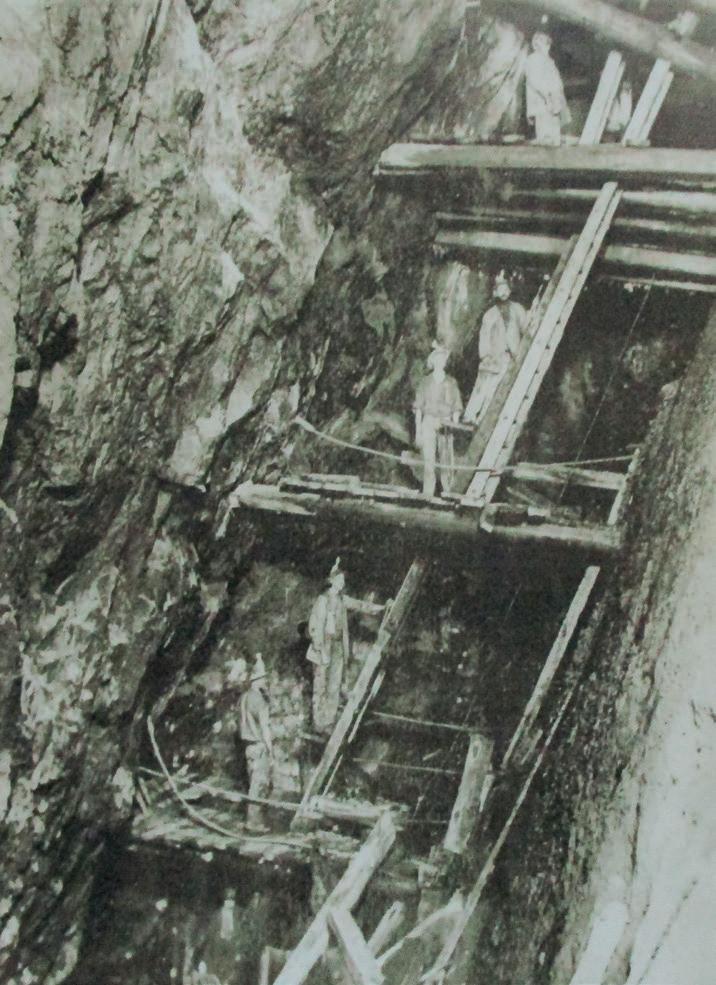
of the mine never reopened. The mine closed in 1930 as tinplate prices halved from £223 to £112/ton.
In 1967, the buildings were passed to the care of the National Trust and the surface buildings and landscape, which are part of the Cornish Mining Heritage Site, are open to visitors. The engine house has a later beam engine which is still run on steam, a unique feature for an engine still in situ
Today, there is a revival for at least one tin mine to reopen in Cornwall as increasing demand for lead-free solders for the electronics industry has increased the price of tin once more. South Crofty mine in Camborne is currently being de-watered to extract a newly found tin-rich lode. �

A balance beam, here attached to a water wheel driving flat rods.




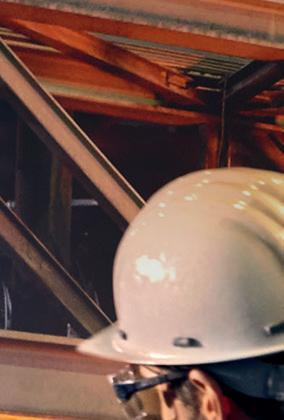
We understand how it is important to efficiently extract and process precious metals and minerals.
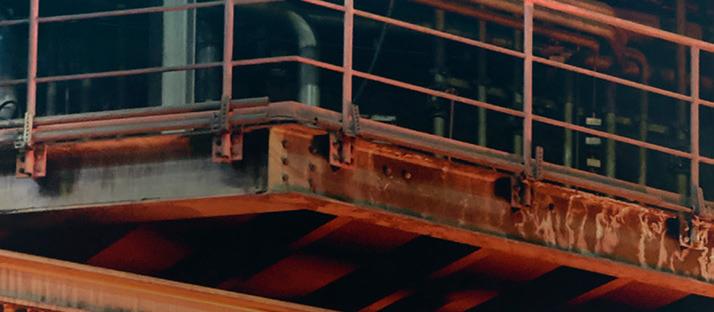













You save valuable resources while keeping your employees and the environment safe.
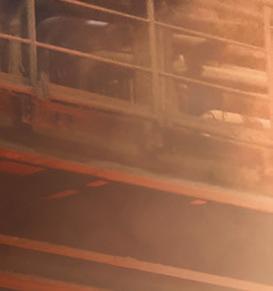



Improve your processes with our comprehensive portfolio of measuring instruments, solutions and services:






Liquiline CM44 and CPS11E: Versatile transmitter and Memosens pH sensors ensure reliable measurement and safe calibration in the lab.


FieldPort SWA50: Intelligent Bluetooth or WirelessHART adapter for the easy connection of all HART field devices to the Netilion Cloud via Edge Devices.


Cerabar PMC71B: Absolute and gauge pressure transmitter combining measurement accuracy with IIoT functionalities.




Q-ONE reduces EAF overall OPEX with a shorter power-on time and very low network disturbances. It is a scalable system that can be implemented on new or existing AC EAFs, and it can be directly powered by renewable energy sources.
